


Did you know Bosnia had pyramids? Shut up, no you didn’t. The majority of people who heard I was going to Bosnia responded with “Be careful! Aren’t they at war?” Guys, that was 30 years ago. So no, it’s a rhetorical question. You didn’t know Bosnia has pyramids.
They’re the controversial kind of pyramids, the kind where some see an ancient pyramid that’s been gradually covered in dirt and trees over thousands of years (as all of the pyramids in Mexico and Central America were before they were discovered and excavated), while others see not a goddamned thing you weirdos that’s just a hill. A Bosnian archaeologist named Sam Osmanagich has spent the past decade uncovering these structures and excavating a network of ancient tunnels beneath, to which the doubters say “What tunnels? Of course there’s a tunnel, you just dug that you goofball.” It’s a fascinating situation.
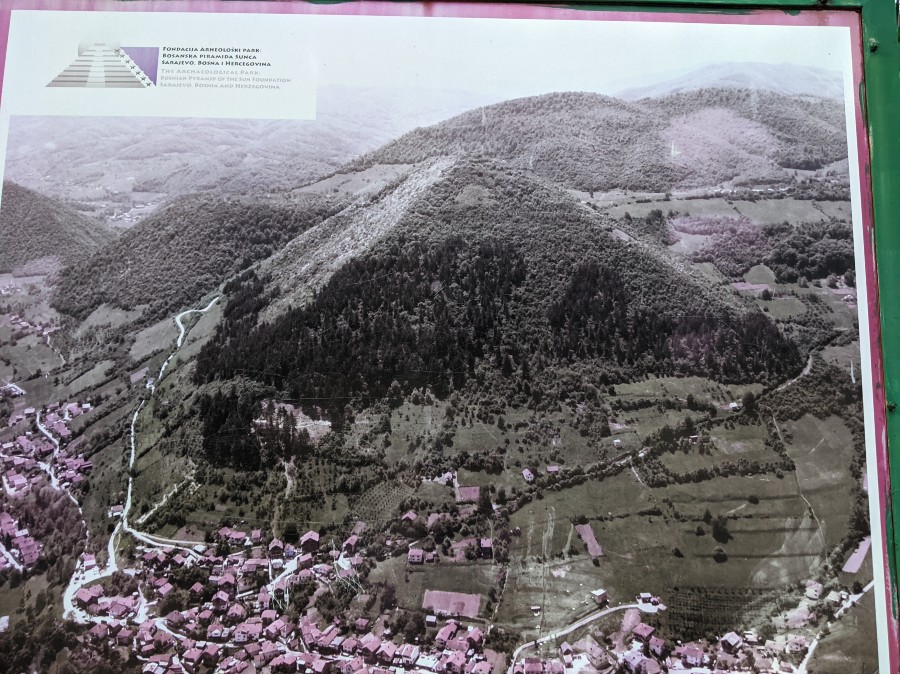
I spent a few nights in the town of Visoko, in-between two of the purported pyramids, the Pyramid of the Sun and the Pyramid of the Moon. I had originally planned to come here with the same group of spiritual friends I traveled to Egypt and the UK with, but covid had delayed that trip again and again and then finally cancelled its wobbly ass, since the rest of the group was not down at all with getting vaccinated. So now here I was on my own, just like the Whitesnake song.
The entire massive pyramid complex had the chaotic vibe of a place that’s only recently been discovered, and then even more recently became something of a minor tourist attraction. It will be fascinating to see if these pyramids ever become scientifically accepted, which could quickly turn them into one of those big deals in the world that people travel to see. In which case, my experience this summer will have been like visiting the Egyptian pyramids in, say, the 1800s. Suffice it to say there was not much in the way of infrastructure and I did a whole lot of walking.
As you climb up the sides of the Pyramid of the Sun, you pass by placards explaining the spiritual and energetic properties of these pyramids, with trippy infrared-looking photos showing lines of energy shooting up out of the pyramid.
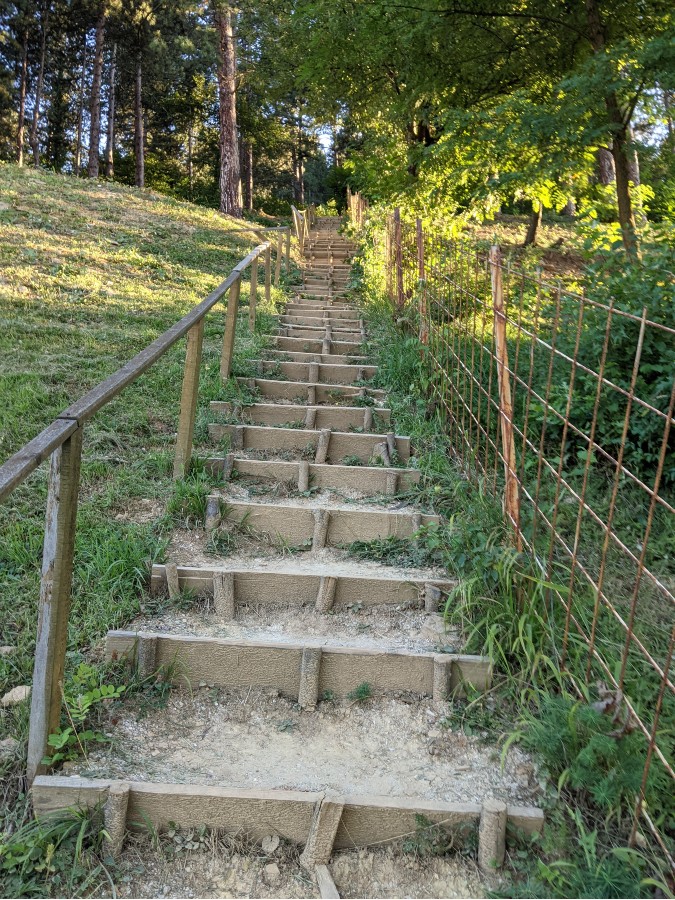
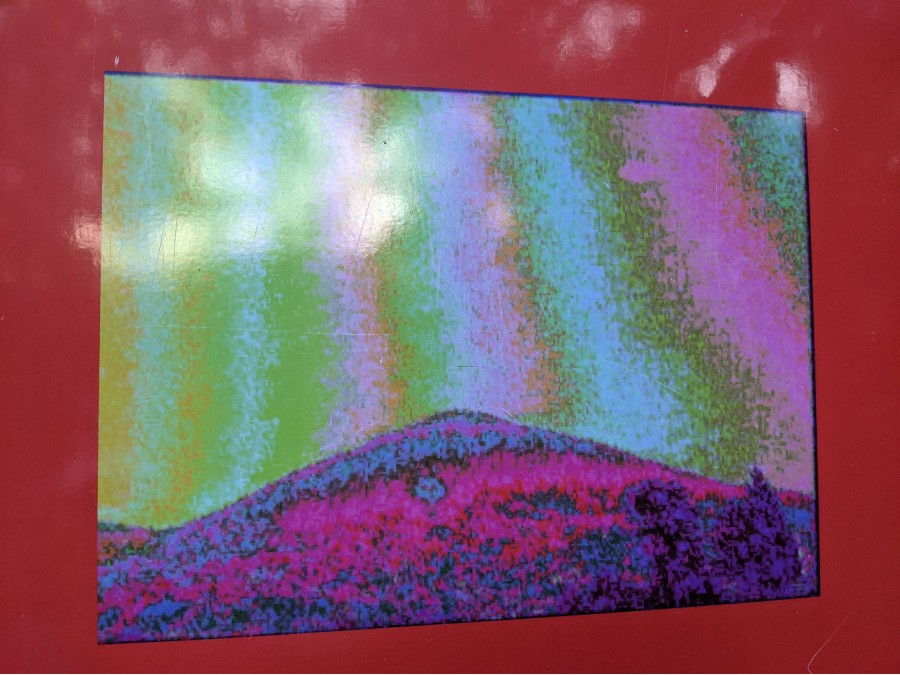
There are quotes and photos from various science-adjacent people talking about how amazing this discovery is, lending some sense of respectability to a bunch of volunteers digging a hole in the middle of nowhere in Bosnia. I was fully onboard with the thought that the pyramids were probably real, but still found the placards amusing, since if you want to convince the skeptical it might be better to not have quotes from a professor at Cosmic Sunshine University.
Likewise, there were numerous misspellings on the signs I would have liked to have helped them with. One of the quotes was from a professor of Archaeology at “Harward University,” which I puzzled over as I wasn’t sure if it was a typo or some hilarious knock-off school for students who weren’t paying that close of attention, like that time I bought socks from Amazong.com.
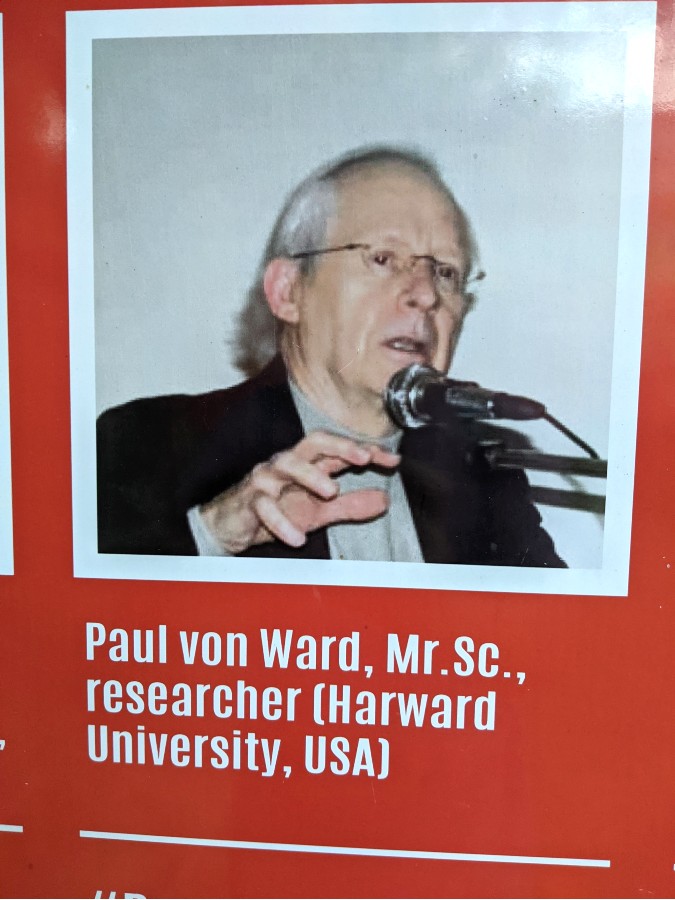
The main thing to see upon hiking up the pyramid, aside from the sweet view of the town receding behind you, are the sections of ground where the dirt has been cleared away, revealing sheets of either an ancient form of concrete or just some naturally-forming concrete-like rock. So, again, eye of the beholder and all that. Signs here explained that the material had been sent to various labs around Europe and confirmed as some kind of ancient magic concrete that’s super-strong.
I found all of this interesting and was intrigued by how the sheets of whatever it was followed the downward slant of the hillside, as they would if they had been the man-made outside of a pyramid. Generally rock layers wouldn’t line up like this, instead you’d be seeing a cross-section of them as they’re exposed. And the material certainly did look like it could be some kind of concrete, a combination of small rocks mixed with a smooth grey substance. But I also recognized that I’m way out of my depth in rock identification here and this kind of thing could also happen naturally for all I know.
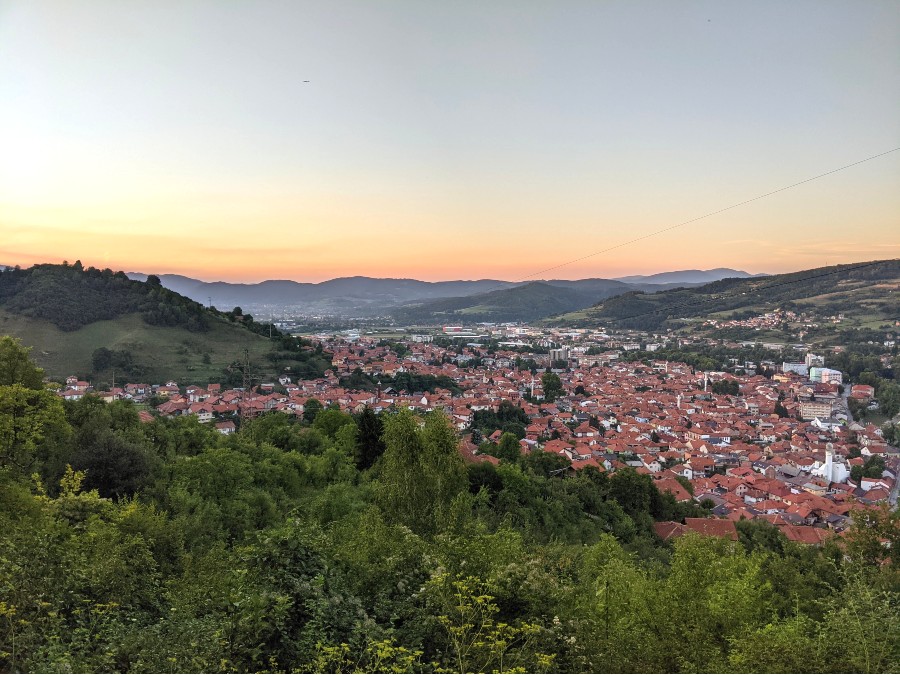
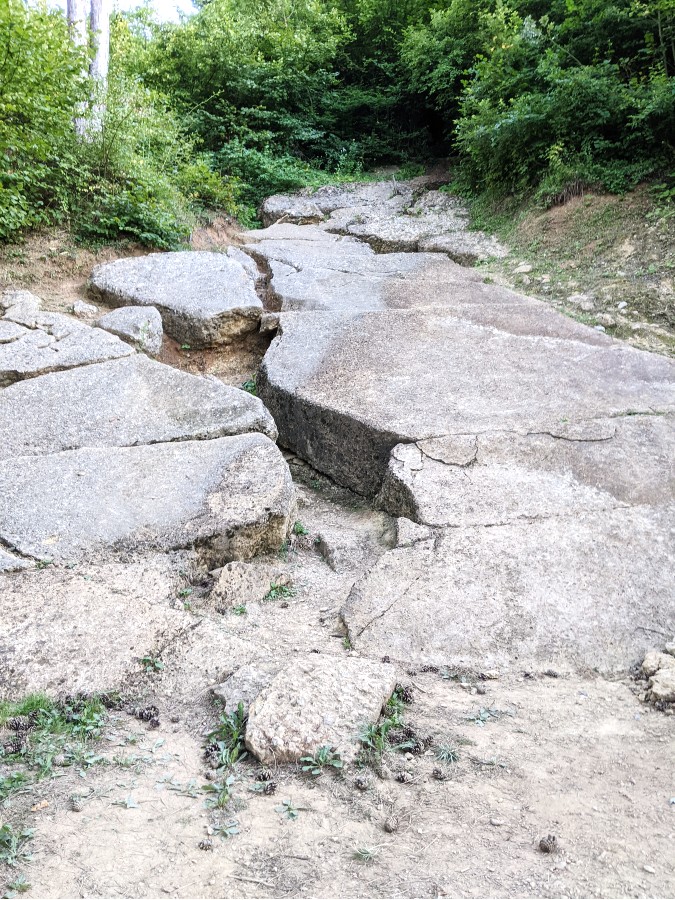
The next day I made the long, long, hot walk through the steep neighborhoods of Visoko to the star attraction, the tunnels that zig zag beneath the pyramids. The first time you visit these you’re required to go with a guide, and since I was the only English speaking seeker who showed up, I had a guide all to myself.
We donned hard hats and ducked into a small rock opening, and before I knew it we were walking through narrow tunnels, the walls covered in the same kind of maybe-concrete as the outside of the pyramid. Down here it was more convincing by a wide margin, as all of the tunnels had the same oval shape, perfect for holding up the tons of earth above the tunnels and hard to argue as naturally occurring. It was also hard to suggest that the volunteers had dug out these tunnels through the hard concrete, as they went on for kilometers underneath the landscape above.
My guide, a smart and cute local girl whose sneakers squeaked in such an odd way I spent the first ten minutes of our trip convinced we were sharing the tunnels with a few billion rats, explained the concepts of the tunnels, that they had been carbon-dated as being 30,000 years old and appeared to have been designed together with the pyramids to focus beneficial Earth energies as well as shielding the people inside from negative energies in the outside world. Many people came to meditate down in the tunnels, but many others just came to sit or lay down in the energetics of the space, and there was a long list of cases of people having health problems cured by a visit to these tunnels.
We stopped at several different very large, flat rocks protruding from the tunnel floor, all located at the intersection points of underground water flows. Visitors were encouraged to hold their hands over the rocks and feel the associated energy. I experienced this as tingling in my hands followed by tiny clockwise swirls of energy. Others felt the sensation move all the way up their arms.
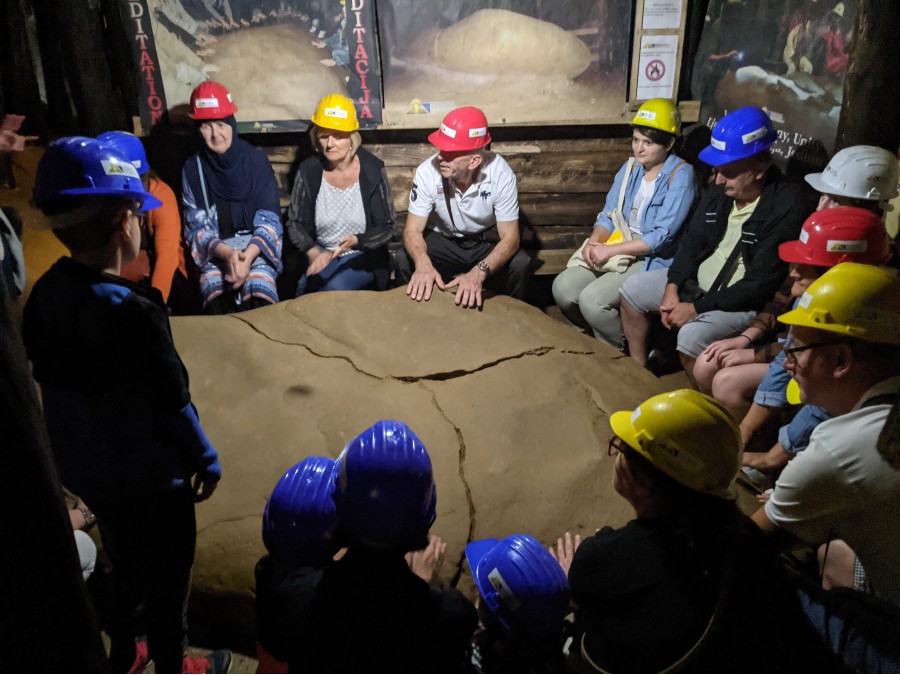
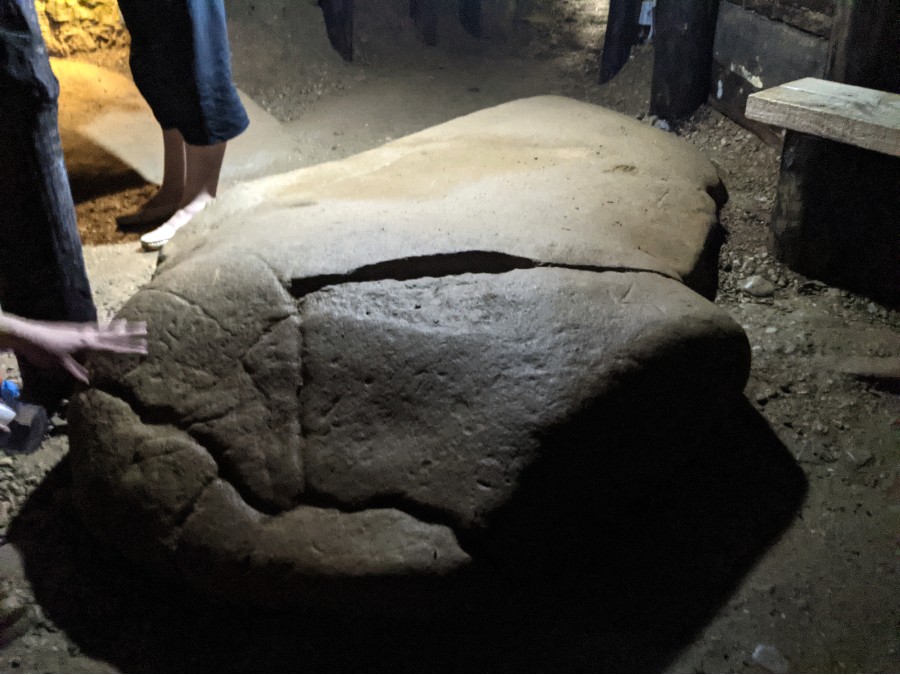
As we proceeded deeper and deeper into the tunnels, lit by battery powered lights and frequently low enough that I had to stoop to get through, I looked at the wooden supports along the walls and contemplated for a second that I was under a whole lot of earth right now and this whole thing was excavated by non-professional volunteers. They wouldn’t be able to keep this place open if tunnels were just collapsing on folks, would they? The government would shut down- Well, wait, this is Bosnia. That could totally happen.
My guide showed me how the various tunnels intersected at little doorways built out of the ancient concrete, and showed me one were a stalagmite had formed in front of an unexcavated tunnel. A sample had been taken from the stalagmite that showed it was at least 30,000 years old, making a pretty convincing case that these tunnels had been open back then and that they predated the stalagmite, since it would have blocked access to that tunnel completely.
At some point, the civilization who had built this place had filled all the tunnels in with soil. One of the large flat stones was found with what appear to be proto-runes carved into it. Two different linguists were given the runes to translate and both came back with some version of “They’re attacking, we must close off the Stargate.” Which, I mean, maybe that translation’s bullshit, but if not, holy shit.
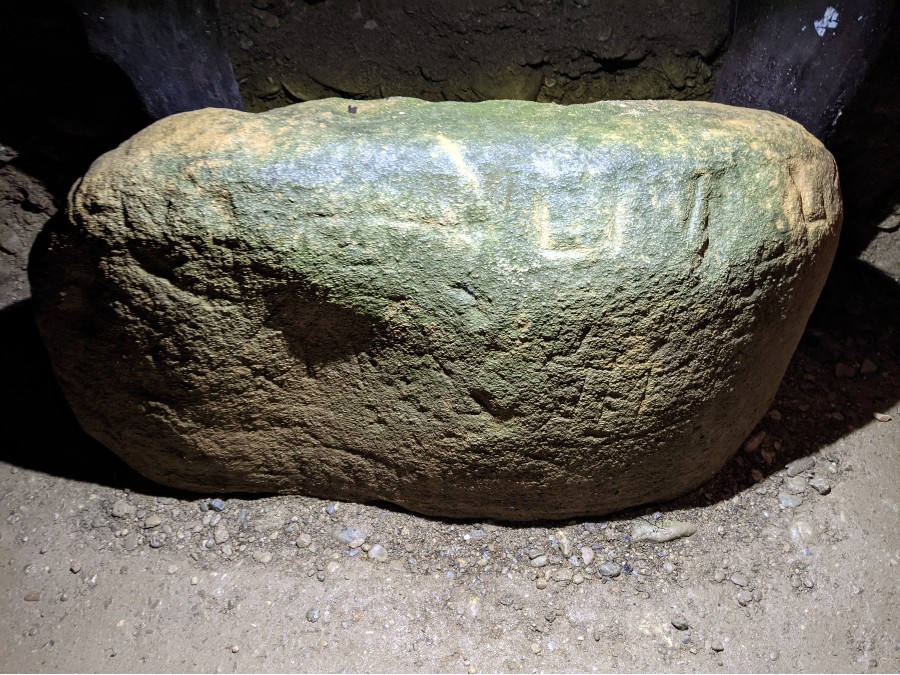
We passed a few blocked-off side tunnels that had standing water visible in them. My guide explained that this water had been sent to Masaru Emoto, the Japanese author who wrote The Hidden Messages in Water, a very influential book in New Age circles, which presented his research showing that water that had been exposed to positive or negative words, thoughts or emotions produced correspondingly beautiful or deformed and misshapen crystals when frozen and looked at under a microscope. His writings tied in further with concepts of water as a conduit for energies, and how our modern system of forcing water through pipes and faucets disrupts the structure of the water and its ability to confer vitality the same way it does in nature.
This is all an area that I’ve been very into for a few years now, after experimenting with various ways to repair the structure of water and imbue it with energies that are beneficial to the body. At home I have various devices for this, and also regularly leave water sitting overnight with orgonite, crystals or other stones, and chanting into water to set the energetics that I want to go to all the cells in my body. I’ve found this to be extremely beneficial and revitalizing. No doubt it would seem crazy to most people, but their belief that such a thing doesn’t exist or isn’t possible isn’t really based on anything, they just haven’t had an experience that would require them to consider such a possibility.
Emoto tested the water from the pyramid tunnels and found it to be beautifully structured, providing magnified photos of the snowflake-like ice crystals. Further testing showed that a small quantity of the tunnel water, added to a liter of regular water and left overnight, structured the entire quantity of water by morning. I tested this myself and found it to be true, producing a very energetically soft and pleasant bottle of drinking water.
Before I knew it my tour was over. My guide informed me that the tunnels were open for independent meditation the last two hours of the day, so I had about five hours to kill. I considered heading to the Pyramid of the Moon, but just the walking for that was going to be a three-hour round trip in the 95 degree heat, and seemed likely to be similar to my experience on the Pyramid of the Sun. I decided instead to explore the park next-door, which had been set up like some kind of spiritual Disneyland.
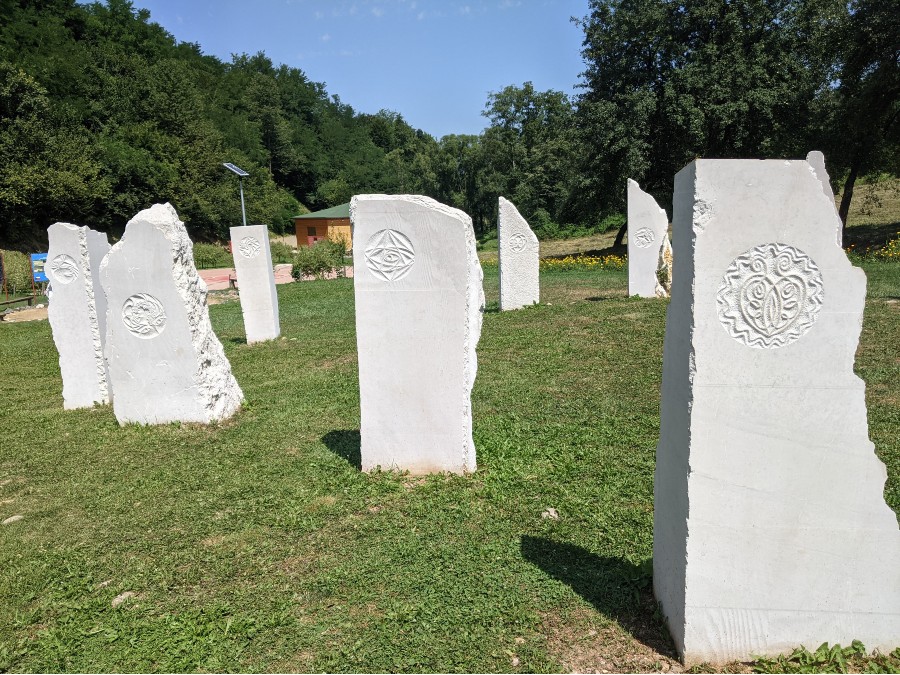
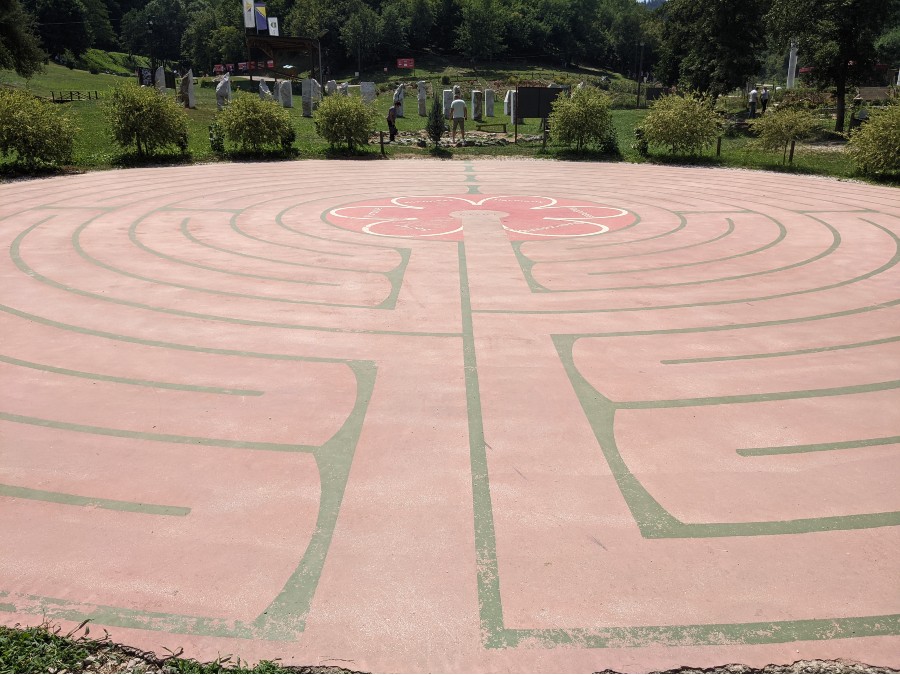
I spent some time walking the contemplative labyrinth and the aura-magnifying crystal maze, then found myself up the hill at a wooden meditation platform in front of a steel pyramid, sitting atop two black and red platforms. I’m not sure if the pyramid actually did anything but I wanted to meditate for a few hours to prepare myself to go back into the tunnels alone, and this seemed as good a place as any. Three adorable little puppies kept me company, alternately playing and napping, as I sat on the platform and gradually quieted my mind until I found myself traveling through successive pyramid-shaped corridors down into inner realms.
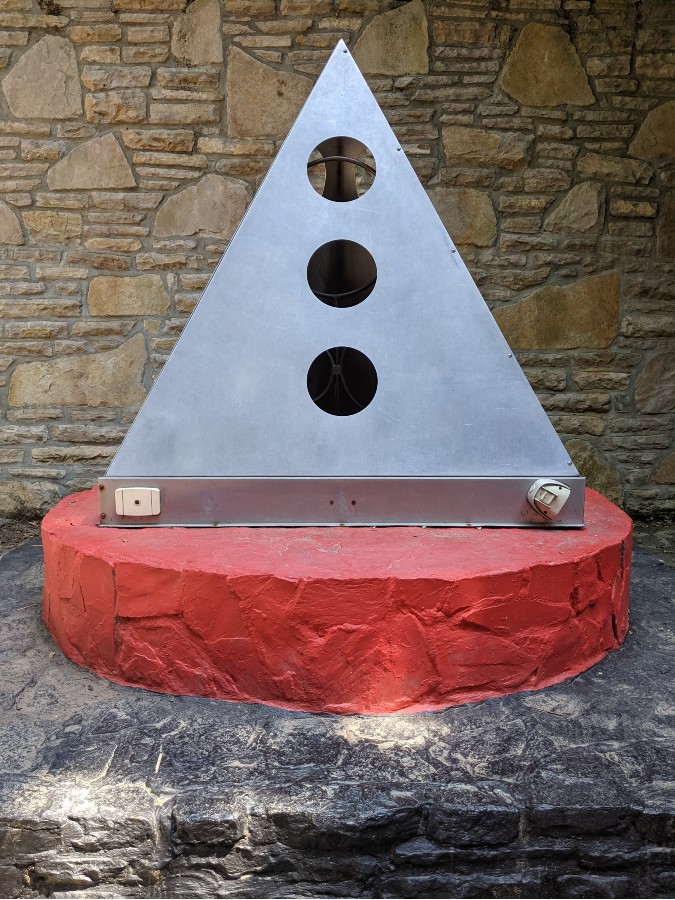
The time went quickly, which is not what people generally say about 4-hour meditations, and I was ready to go back into the tunnels.
The way this worked was surprisingly chill. I paid a small fee to one of the volunteers, grabbed a hardhat and headed down into the depths all on my own, like I was off to work. My guide earlier had encouraged me to go as deeply into the tunnels as I could, as the energies were stronger the further you got away from the surface. You don’t have to tell me to explore mysterious spiritual tunnels under the Earth twice, and before long I was deep down one of the winding corridors. This was completely amazing, as there were very few people in there and the tunnels went on seemingly forever. I felt like Indiana Jones as I stooped down under the low ceilings and imagined what could possibly be around each new corner. A dinosaur? Elvis? Who the fuck knows? I ended up exploring all three of the branching tunnels to their ends, finding some very isolated spots to sit and meditate.
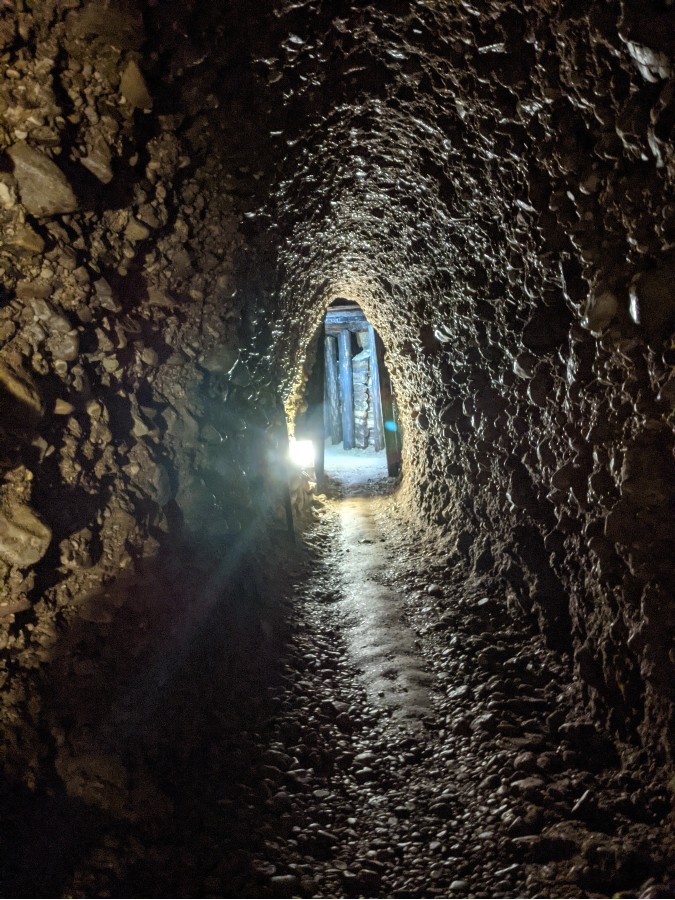
Meditating deep in these tunnels was an enchanting experience, since for me at least it wasn’t about connecting to higher realms or receiving some kind of message or epiphany. It was about being deep in these Earth energies and just being present with that. As I sat in the absolute silence I began to hear the sounds inside the silence loudly and clearly, various wawawawawawa and THUDTHUDTHUDTHUDTHUD sounds that I interpreted as hearing the wavelengths of the Earth energies I was experiencing. This was deeply fascinating and strange.
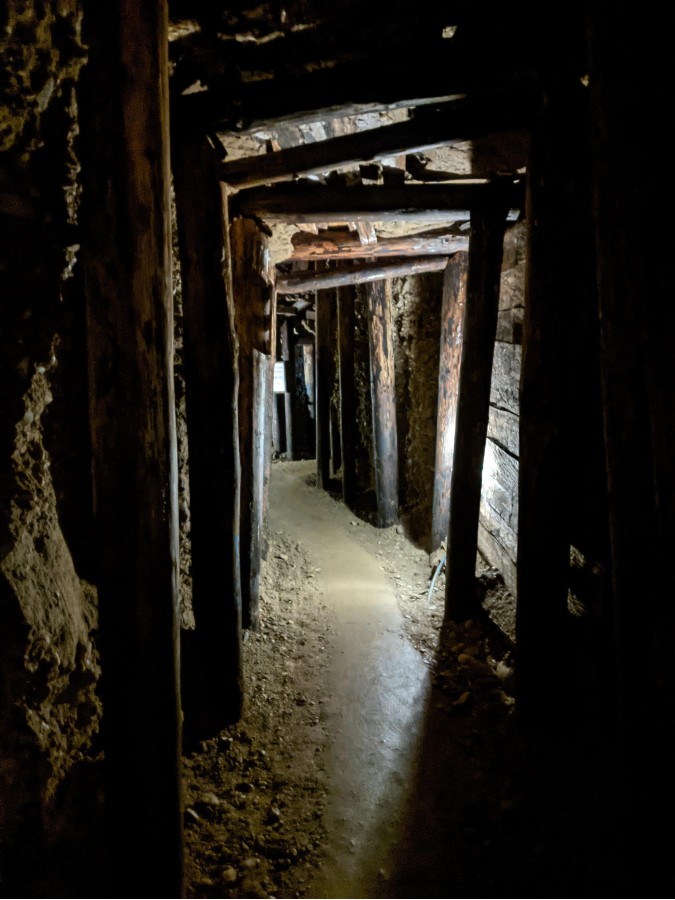
I left convinced that the tunnels had been built by people with knowledge of working with these Earth energies. Maybe the hills above really are pyramids, maybe they aren’t, but I experienced enough inside to be convinced that the tunnels weren’t just something random dug out by volunteers to trick tourists. It will be fascinating to see how the site and our knowledge about it progresses in the years to come.
Sarajevo is a city uniquely haunted by the memories of war. This goes back a ways.
Hey, wasn’t this the street corner where Franz Ferdinand was assassinated in 1914, kicking off WWI?
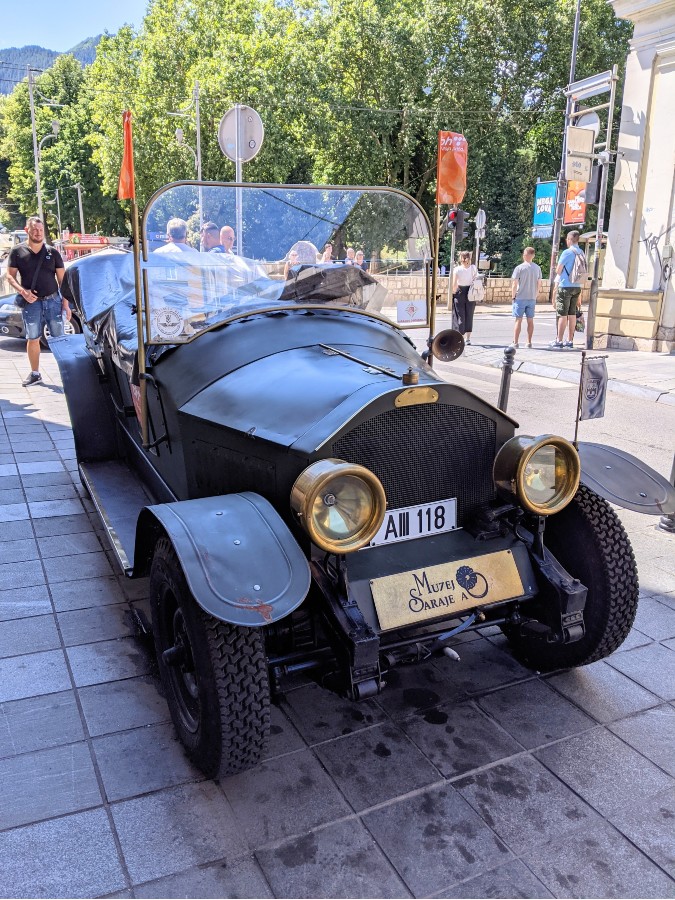
He probably regrets that he was singing “Take Me Out” at the time, now. Talk about bad timing!
It was eerie to stand on this street corner, across from the Latin Bridge, interacting with a distant historical moment I’d heard about since grade school. Not something I ever expected to happen when I was seven and wondering what an Archduke was or who was invited when Austria and Hungary got married.
This whole scenario is fascinating for a few reasons. First off, don’t feel bad for Franz, he was kind of a shitbag. He spent most of his free time shooting elephants, kangaroos and emus and kept a diary of the over 270,000 things he’d killed. Even in the late 1800s, people were like “Damn, Franz, ever heard of therapy?” He had not. And keep in mind this was the 1800s, when you could bathe in virgin servants’ blood and people would still be like “Hey, YOLO.”
Franz was heir to the Austro-Hungarian throne only because his cousin, Prince Rudolf, banged so many random ladies he gave his wife syphilis and she couldn’t conceive, a tragedy he consoled himself in by falling in love with his 17 year old mistress, and then shooting her and himself because he couldn’t leave his ruined wife for a teenager. Nine years later, Rudolf’s bereaved mother, Empress Elisabeth, was stabbed in the heart with a file by an Italian anarchist in Geneva as she walked to board a boat. Her assassin was there to kill the Duke of Orléans, who had left a few days earlier, but, say! Isn’t that the Queen of Hungary? This was not an exceedingly lucky family.
So Franz was in line for the throne by default. Meanwhile, Bosnian revolutionaries who wanted to drive Austria-Hungary out of Bosnia were planning to kill the governor of the Bosnian province. This was turning out to be a pain in the ass and conveniently Franz Ferdinand was coming to town to make sure the imperial army wasn’t screwing around, so they decided to kill him instead. The newspaper had conveniently published the itinerary and route for the Archduke’s visit, and six teenaged student assassins were positioned along the route. The first two chickened out, no doubt intimidated by Ferdinand’s impressive mustache. The third winged a bomb straight at the Archduke’s car, swallowed a cyanide pill, and leapt into the river.
This was completely badass, but none of those three things went as planned. The bomb bounced off Ferdiand’s open-top convertible and exploded underneath the next car in the motorcade. The cyanide suicide pill was too old and only caused vomiting comparable to exposure to a John Tesh album. And at that time of year, the river was only six inches deep. Whoops.
The motorcade continued on to the Town Hall for a planned reception. This is hilarious to me, but this is just how the 1800s were. You can’t go changing plans just because people are throwing bombs at the Archduke. Likewise, the local military commander had ordered the motorcade route to be lined with soldiers, but this was vetoed on the grounds that it would look bad. And the security officers who were supposed to be with Ferdinand got in the wrong car at the train station. It’s really not that surprising that royalty were constantly getting assassinated back then.
Franz was so pissed off at the assassination attempt that he almost couldn’t give his speech at the town hall. He also almost couldn’t give it because the literal speech was in the car that was blown up, and they had to sift it out of the wreckage and deliver the blood-soaked papers to the Archduke after such an annoying delay. But after giving the local Mayor a good cussing-out, Franz calmed down and talked about trade embargoes or whatever other first 20 minutes of The Phantom Menace BS he was there to talk about.
Ferdinand’s people insisted that surely now was the time to line the streets with soldiers to protect the Archduke, but the local officials protested. The soldiers weren’t dressed and it would look terrible if they were wearing their Wednesday tufted feather hats on a Tuesday, I mean come on. And what, do you think this town is full of assassins or something? Don’t be silly, we got the one after he dove into that kiddie lawn pool we call a river.
So the entourage headed out again, altering their plans to instead visit the hospital where everyone from the bombed car was being taped back together and leeched. Except the guy in charge of telling all the drivers that the route had changed was one of the ones in pieces at the hospital.
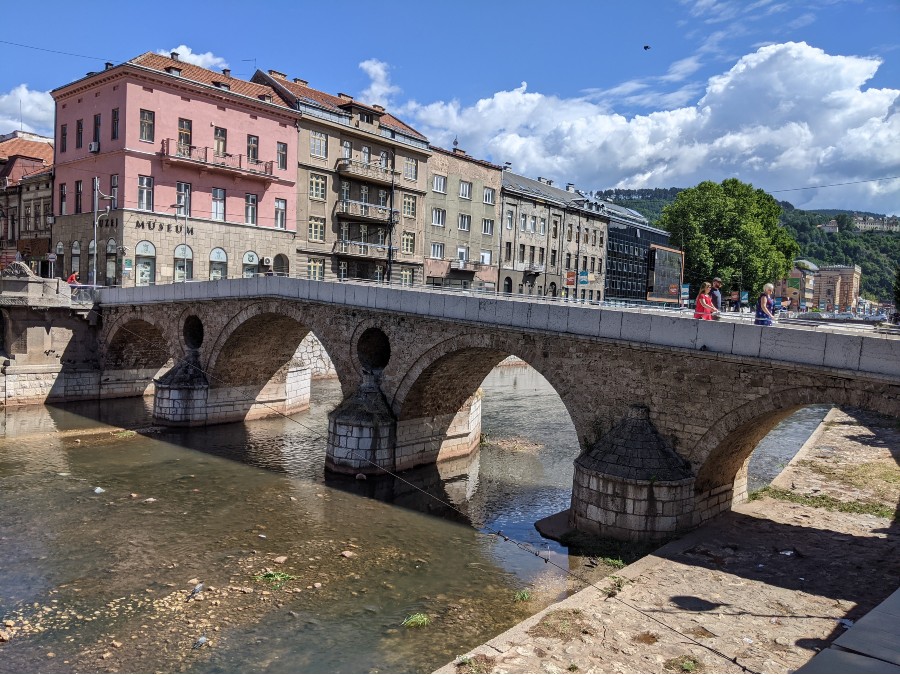
Meanwhile, one of the three remaining assassins, 19 year old Gavrilo Princip, was hanging out in a delicatessen near the Latin Bridge. He was trying to figure out where he could possibly find Franz Ferdinand to shoot him, when the motorcade suddenly drove by the window. Whoa! He went outside, but of course it was too late-
The motorcade drivers had made a wrong turn and the governor of Bosnia, the very man the assassins had been planning to kill in the first place, who was sharing a car with the Archduke and his wife, yelled for the driver to stop and back up. The driver obliged, but stalled out the engine trying to put it in reverse. All this, right in front of Gavrilo Princip, who was standing on the street corner wondering when he might get another chance to shoot the Archduke of Austria-Hungary.
I mean, good god, maybe this guy was just meant to die. Elephant karma’s a bitch.
Princip stepped up on the car’s running board and shot Franz in the neck and his wife Sofie in the abdomen at point-blank range. He later claimed that he was actually trying to shoot the Governor with the second shot, which I mean, maybe, but goddamn man you were standing on the car itself, unless everyone inside was breakdancing you are a terrible shot. Princip then tried to shoot himself, but was wrestled to the ground by the local police in their last-ditch effort to be of any use whatsoever.
I can only explain what happened next by suggesting that everyone in the 1800s was in a collective state of denial about pretty much everything. Everyone decided that everything was fine, no one was hurt, and they should proceed to the Governor’s house. The drivers set out. Then, to the shock of all, blood started to pour out of the Archduke’s mouth. Duchess Sophie looked at this and actually said “My goodness! What happened to you?” Then she promptly collapsed into her husband’s lap and died straight away. This being an optimistic century, everyone thought she had just fainted, because apparently they had also already forgotten about the whole assassin shooting up the car thing. It was a busy day.
Then Franz slumped over. But no one was alarmed at all until his tufted feather hat fell off.
“My god! Are you alright?” they asked.
“I’m fine!” he replied, completely full of shit.
He repeated “I’m fine, I’m fine, goddammit I’m fine-” in a softer and softer voice as he died. Never wanting to be a bother, that Archduke Franz Ferdinand.
Because the young assassins were Bosnian Serbs, Austria-Hungary ended up declaring war on Serbia and gradually more and more allies on each side were dragged into the mix until we had World War I, which ended with the complete dissolution of the Austro-Hungarian empire. Years earlier, while game hunting, one of Franz Ferdiand’s porters had fallen down and the gun he was carrying went off, the shot missing the Archduke by about a foot. If only that porter had been just a tiny bit more clumsy, we might never have had WWI, 20 million people would have been spared and Austria-Hungary might still be a thing today. But, my first day in Sarajevo would have been a little bit less interesting so it all sort of evens out I guess.
And so Sarajevo lived happily ever after... wait, no it didn’t. Very much no it didn’t.
In time, young Gavrilo’s dream did come true. He didn’t live to see it, but not because he was executed for killing the Archduke. Unlike today, back then they had weird principles about not murdering teenagers no matter what kind of shenanigans they got up to, so he was sentenced to 20 years in prison instead. And then he caught tuberculosis in prison, lost his arm and died. Three months later, World War I ended, Austro-Hungary was no more, and the south Slavic people finally got their own country. It would eventually come to be known as Yugoslavia.
After being occupied by the Nazis in WWII, Yugoslavia emerged from the war as a Communist nation under Josip Broz Tito, who captured the imagination of the population with his campaign slogan, “Broz Before Hoes,” which everyone loved because they were sick of farming. Due in part to a less-centralized version of socialism than what was being practiced by their Eastern European neighbors, by the 1960s and 70s Yugoslavia was prosperous and in an enviable position, on good terms with both the Soviet Union and the United States. Yugoslavia’s people could afford Western goods and vacations around the globe. Then Tito had to go and die in 1980, and it turned out he was the only thing holding Yugoslavia’s many ethnic groups together and focused on a common objective.
Tensions boiled up through the 80s, as the constituent states became less and less interested in being shackled together and Serbia, which had been the central power of Yugoslavia and which basically had the attitude that "You're all Yugoslavia forever, and by Yugoslavia I of course mean Serbia", became less interested in listening to anyone’s complaints. In 1990 the Communist governments of the various Yugoslav states fell one by one and were replaced by democracies, and in 1991 Slovenia and Croatia declared their independence. Bosnia would follow in 1992.
Serbia called bullshit on this nonsense, and promptly invaded Slovenia. Ten days of fighting followed, in which a well-planned guerilla campaign allowed little Slovenia to embarrass the much larger Yugoslav army, defeating their forces and thanking them for the donation of tanks and ammunition. Serbia changed their minds and decided “Eh, you guys don’t have enough Serbs for us to bother with this,” and pivoted to attacking Croatia instead. Fighting in Croatia continued off and on for four years, with the Croats eventually prevailing because Serbia was too busy beating the living shit out of Bosnia.
Serbia’s real objective was the creation of a new all-Serbian Yugoslavia, encompassing not only all of the Serbs living in the Eastern half of Bosnia-Herzegovina, but also the land they were living on, thank you very much. Croatia had similar designs on the Western half of Bosnia, where a large number of Croats lived. So Bosnia found themselves fighting Croatia and Serbia, alternately and sometimes at the same time, just to hold onto their territory and not end up as the tiny nugget of land in the middle that would have been left for Bosnia’s muslim majority.
Later that same year, Macedonia declared their independence, and Serbia didn’t even notice. This is a controversial statement, I know, but records indicate Serbian president Slobodan Milošević was quoted as saying “Macedonia? Where the hell is that?”
The war in Bosnia dragged on for 44 months, with the city of Sarajevo somehow finding itself under siege for 46 of these. I’m not sure how that math works either. Serb troops set up in the mountains encircling Sarajevo, cutting off all heat, electricity and water to the city as well as all aid and supplies, and proceeded to rain hundreds of shells indiscriminately down onto the city every single day for nearly four years. The UN and NATO got involved, but largely did more harm than good for most of the war, providing “help” like declaring a village as a safe zone and then standing by idly when the Serbs showed up and killed everyone who’d come there for UN protection. An international arms embargo meant that the poorly-supplied Bosnian army couldn’t get the weapons it needed to break the siege of the city, and this stalemate meant thousands of civilians died in the neverending shelling. The UN seemed primarily concerned with not taking sides, which allowed the war and associated war crimes to drag on. The UN did take control of the Sarajevo airport, which became the only way out of the besieged city, but any Bosnians who tried to escape across its runway to freedom were rounded up by UN troops and returned to the war zone. Thanks guys.
Ultimately, the Bosnians realized they were on their own, and so they dug a tunnel.
I took a long bus ride and then another bus and then walked way too far on a shoulderless road to the outskirts of town on the far side of the airport to see this for myself. There sits a house that has become a museum to the Sarajevo Tunnel. Two teams, one inside the besieged city and another in the free territory outside, secretly dug a tunnel underneath the airport runway, eventually meeting in the middle and creating a lifeline to Sarajevo from the rest of the world. The finished tunnel allowed civilians to escape, the wounded to be evacuated, and desperately-needed food, medicine and weapons (which thanks to the UN blockade, the Bosnians had to buy from Columbian drug cartels to defend their city) to be moved into Sarajevo from the rest of Bosnia. This tunnel played a pivotol role in the survival of the city, until the UN and NATO finally figured out that they probably shouldn’t keep letting Serbia murder civilians forever and began the air strikes on Serbian artillery positions that eventually ended the war.
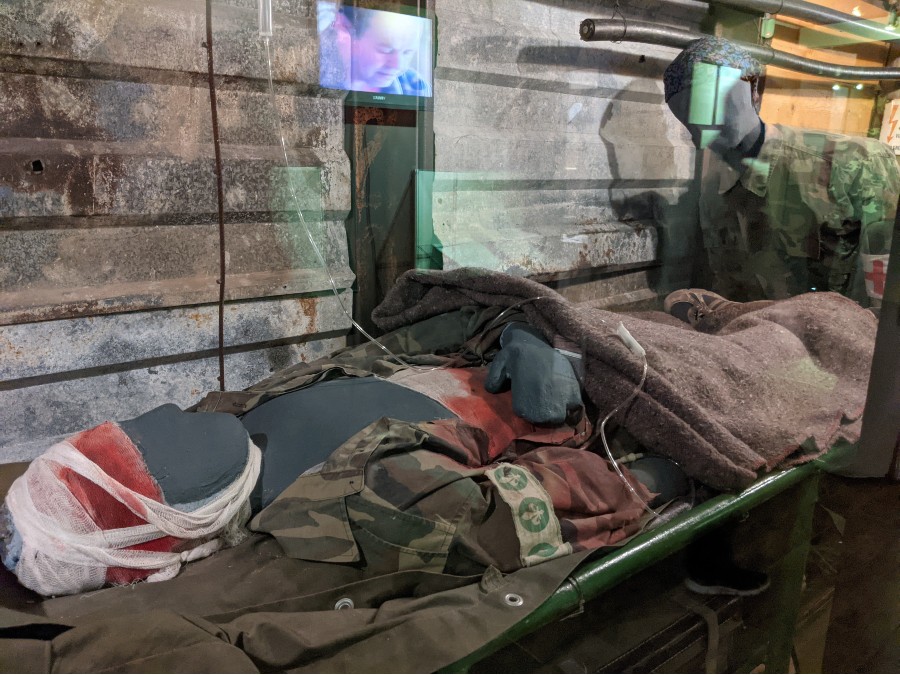
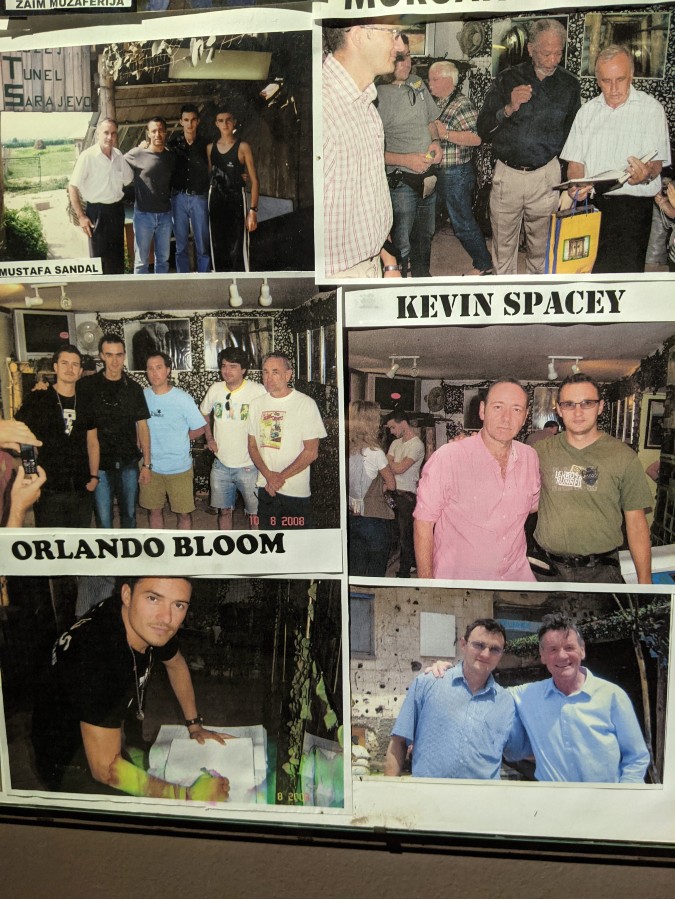
From the museum you can scurry through a preserved section of the tunnel, which gives you a sense of how crazy it must have been to pass through this back in the 90s, in the dark, trying not to stumble over the homemade cart tracks on the floor or slip on the accumulated water on the floor of the tunnel, hunched over and carrying a pack heavy with supplies if you were headed into the city, or everything you owned if you were fleeing in the other direction.
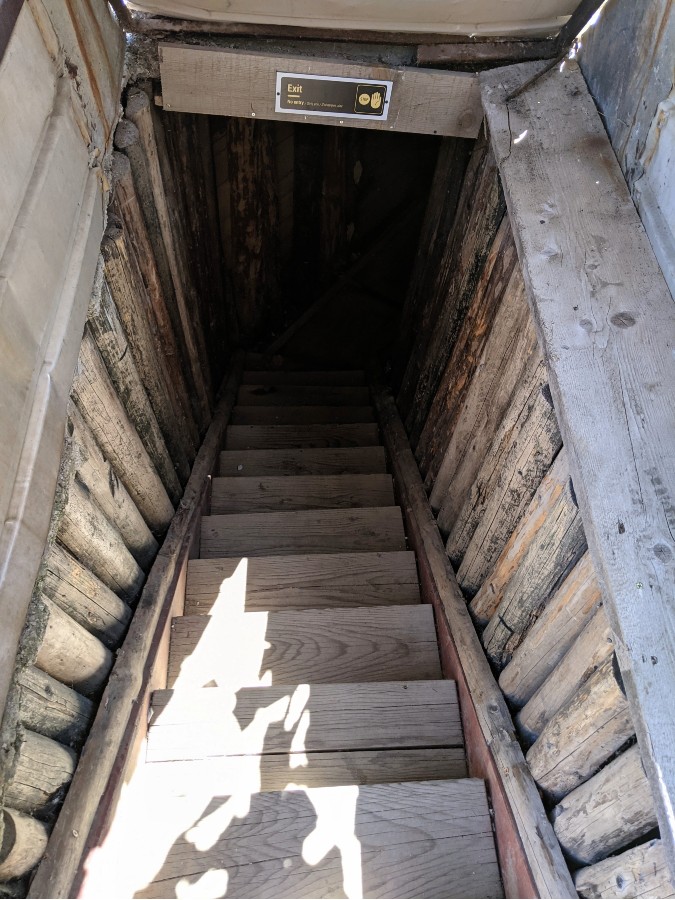
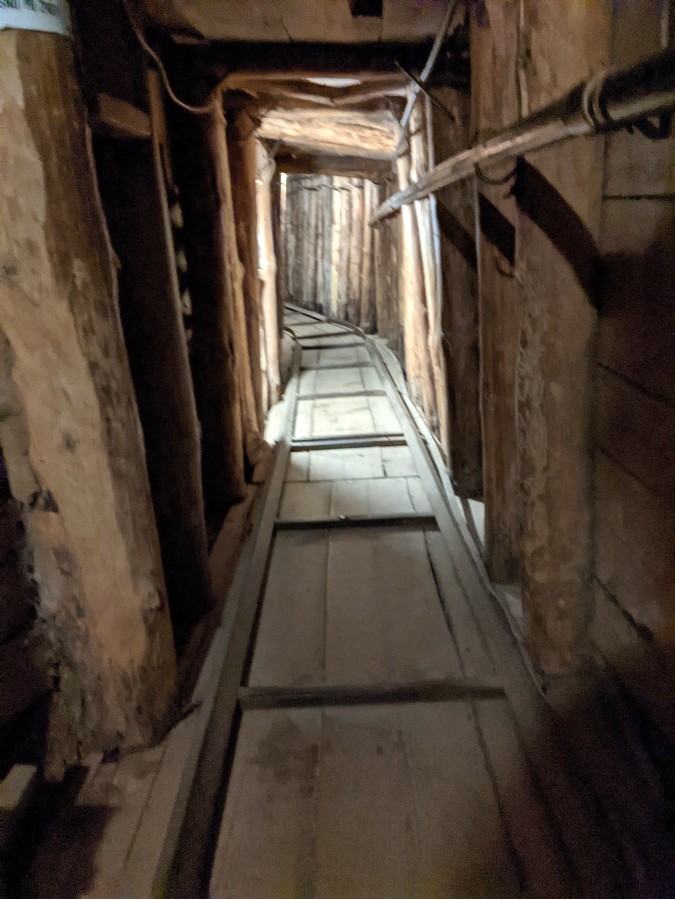
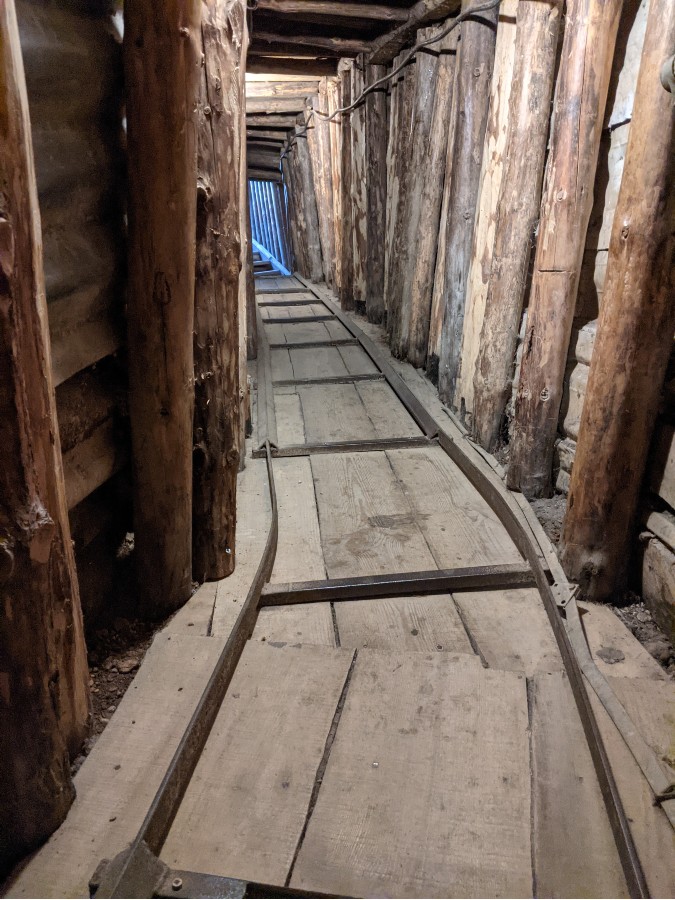
“Sean how did you spend your time in Bosnia?” “Mostly wandering around in unprofessionally dug underground tunnels.” “Right that’s what I figured.”
At various places in Sarajevo the impact craters of shells and grenades are filled with red paint, these memorials to the war known as Sarajevo Roses.

Across town you can find the bizarre ICAR Monument. ICAR were cans of emergency mystery meat that the UN airdropped into the city while it was under siege and the residents of Sarajevo were burning sneakers for warmth and huddling in whatever room in their house had the fewest windows that could be blown in by the constantly falling shells. The ICAR rations were famously horrible, some kind of 20 year expired Vietnam War-era rations that stray cats and dogs wouldn't touch, a dubious mercy rained down on people who were already having a bad enough day before they had to try and eat this shit. Also, a lot of it was apparently pork, which is a bit of an issue in a predominantly Muslim country. As a thanks to the world, the people of Sarajevo built the sarcastic ICAR monument, a giant can of inedible porpoise meat or whatever the powers that be decided Bosnians liked to eat while they were being bombed.
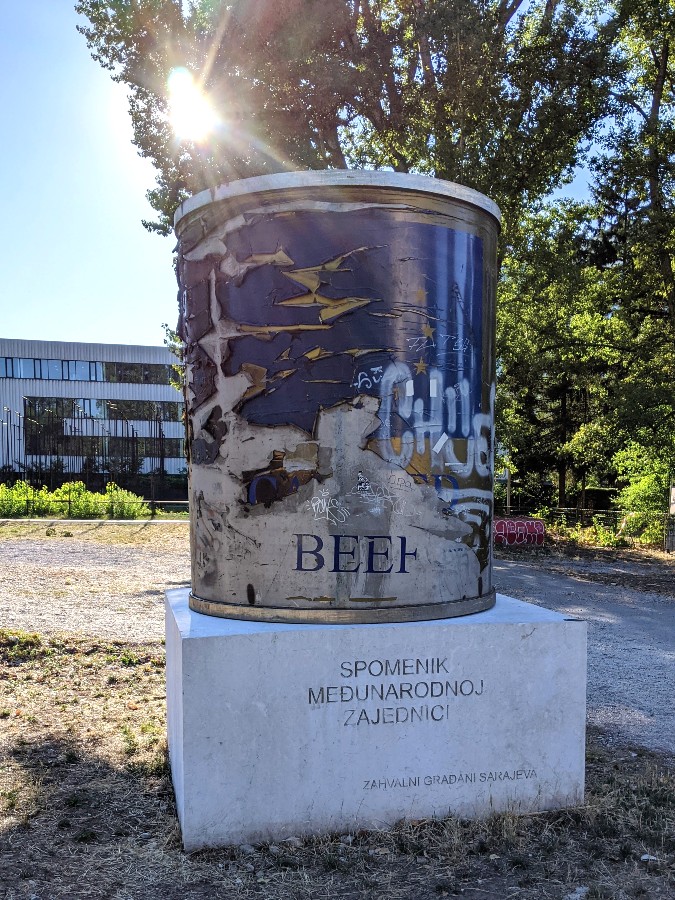
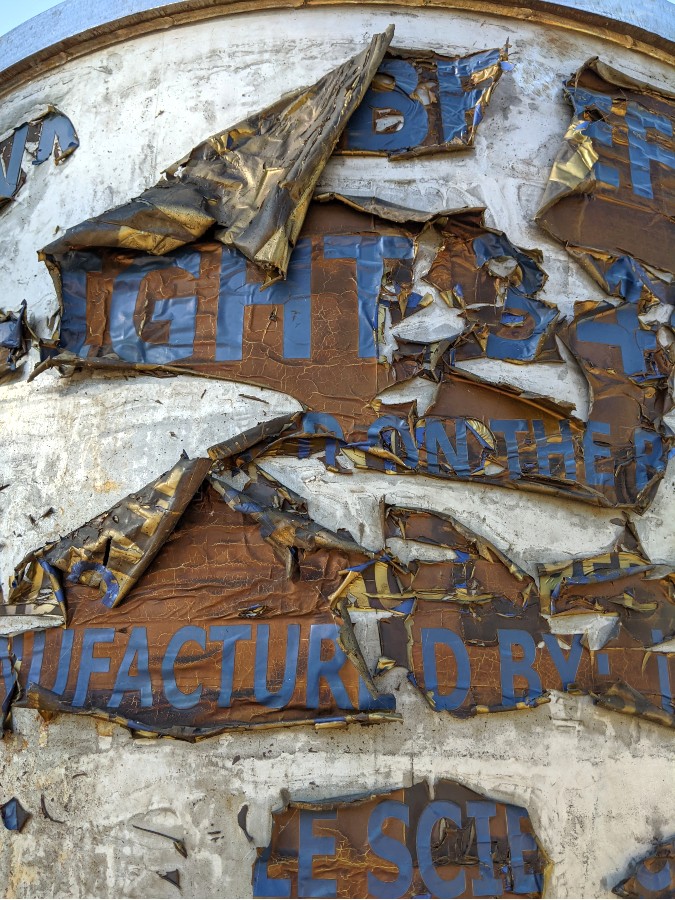
I took the cable car up into the mountains surrounding Sarajevo, the city beautifully receding behind me as I rode up into the green.
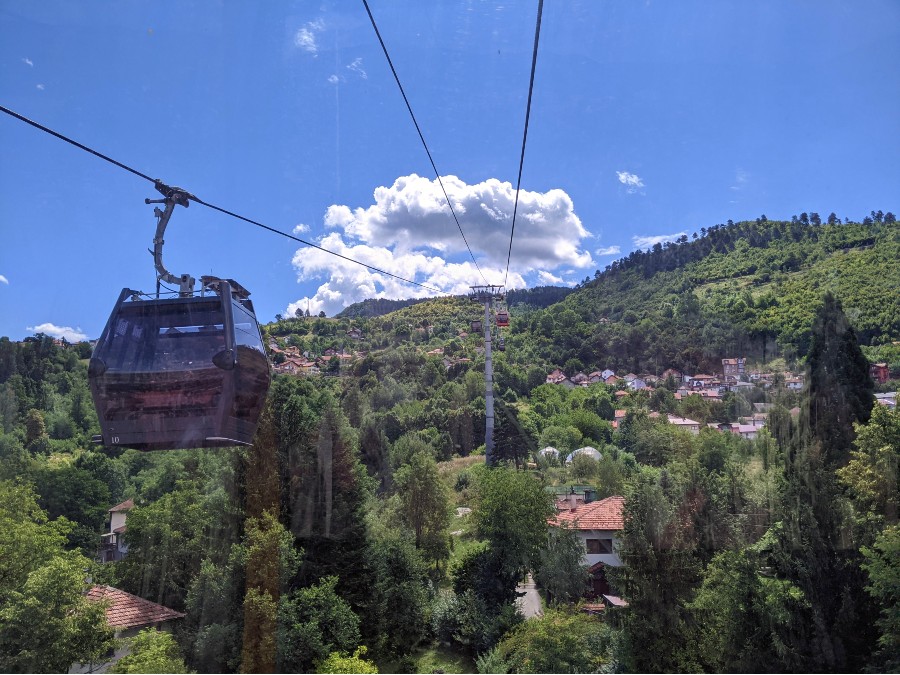
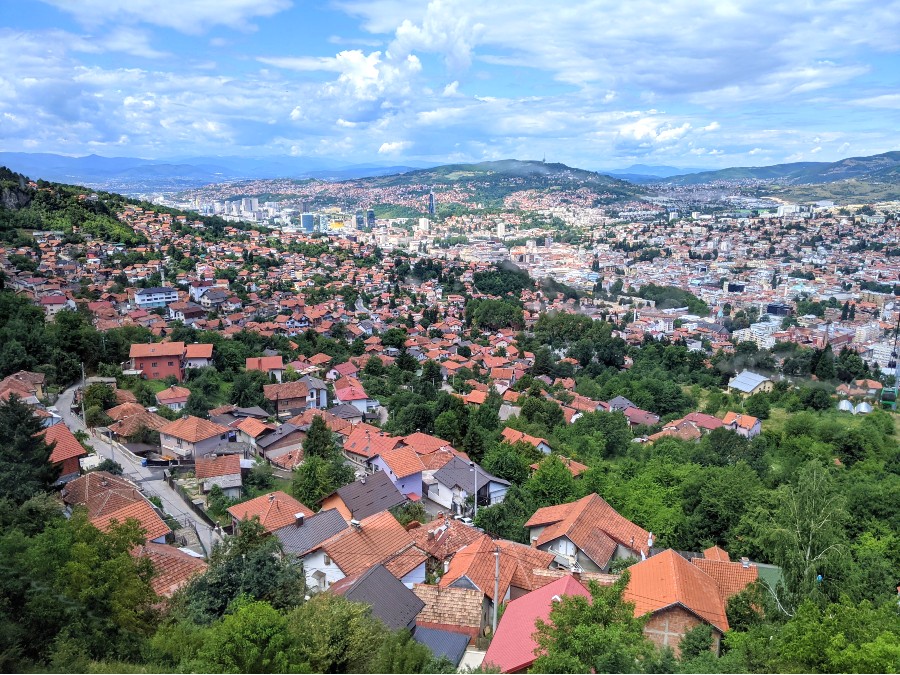
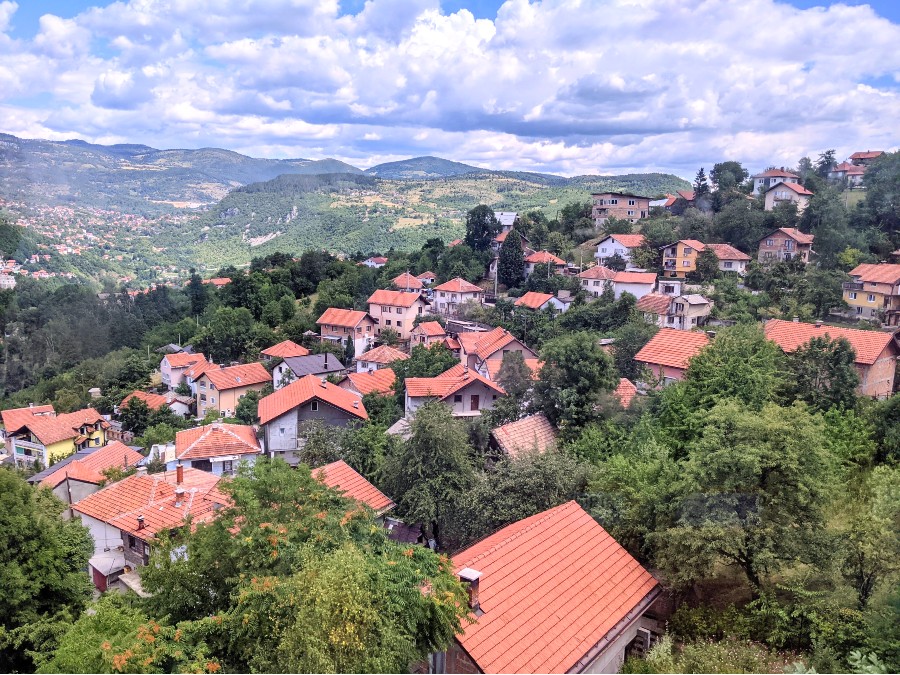
Up top it’s a short hike past some weird old Olympic shit to the bobsled tracks from the 1984 Sarajevo Winter Olypmics. A few short years after hosting the Olympics, Bosnia was at war, and the concrete bobsled runs became impromptu bunkers as the Serbians rained down fire on the city and the Bosnians fired back up into the mountains. Today, the bobsled runs are covered in graffiti, which barely hides the bullet holes and impact craters in the concrete.
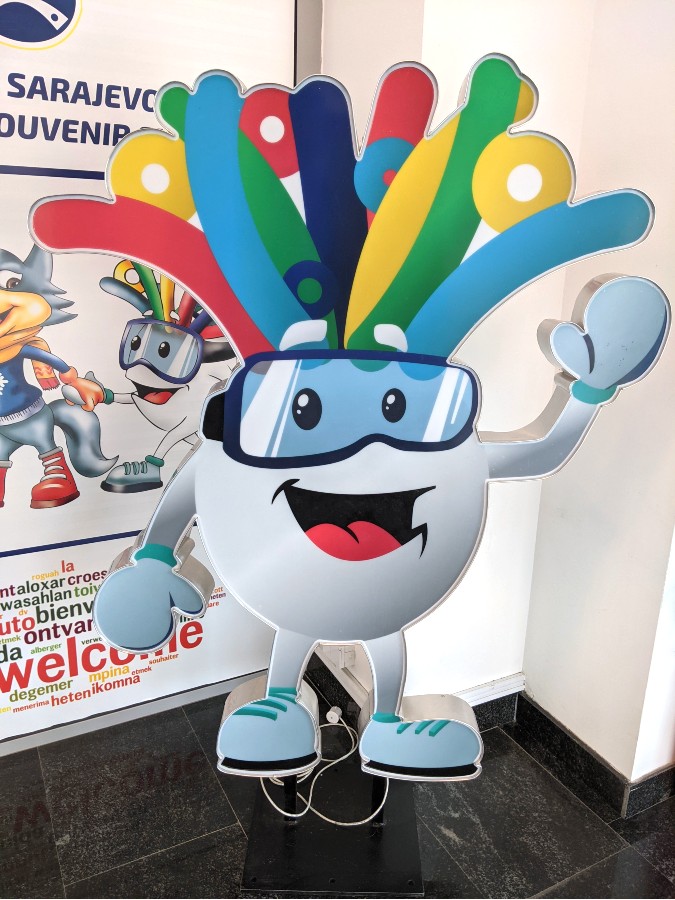
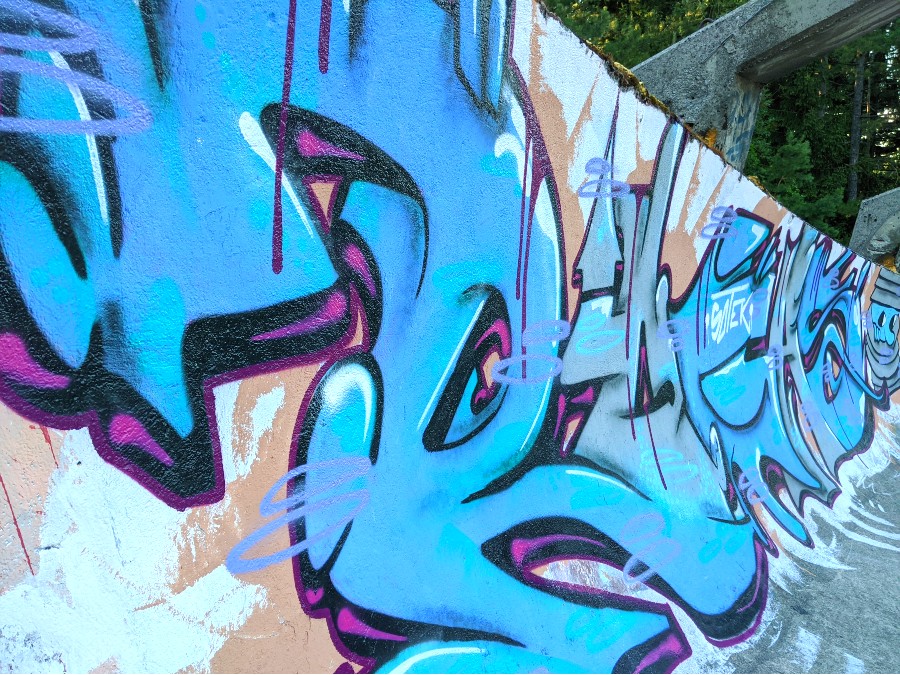
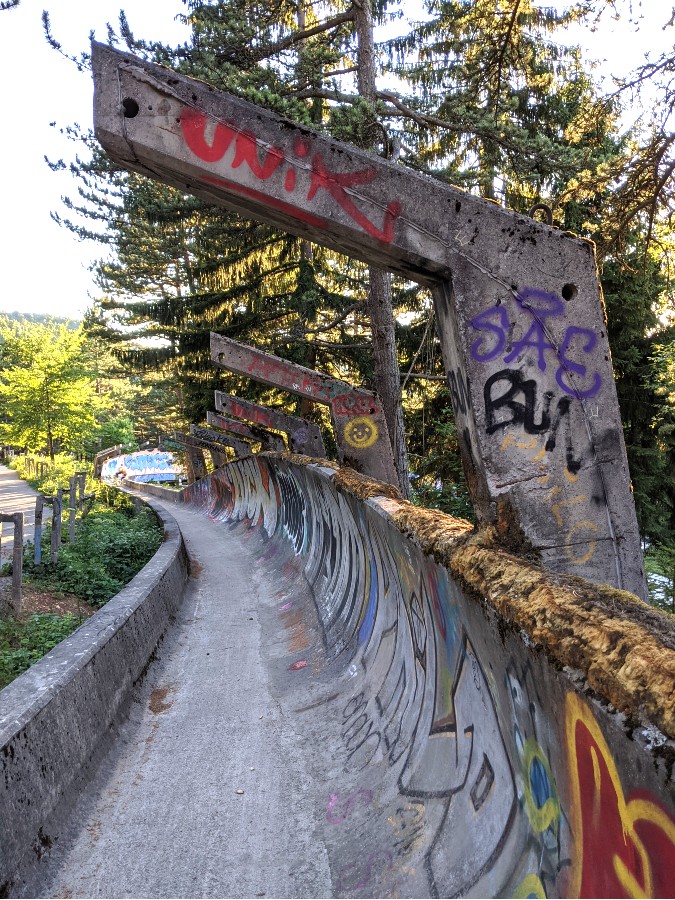
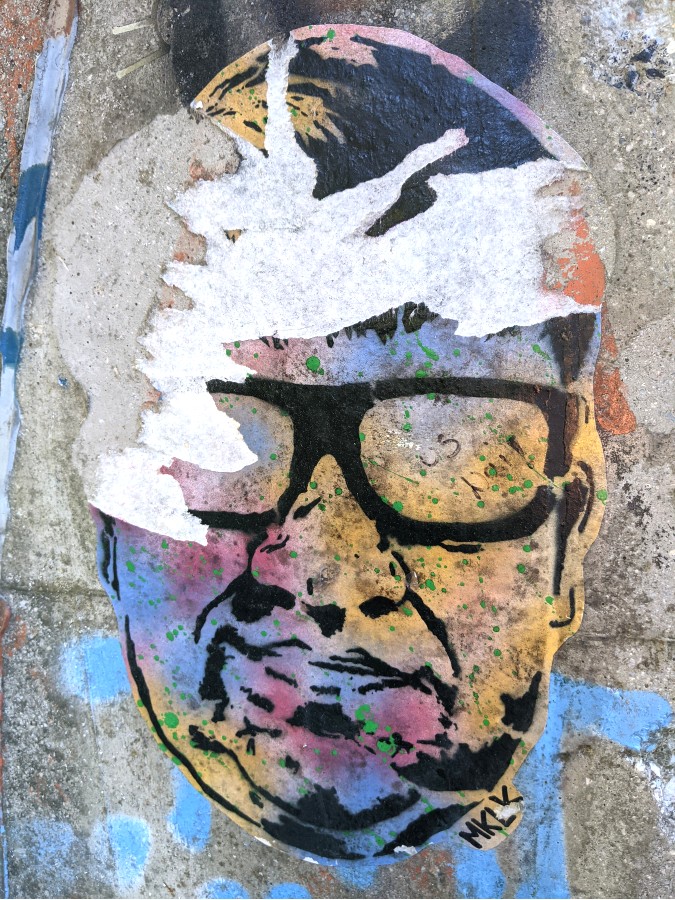
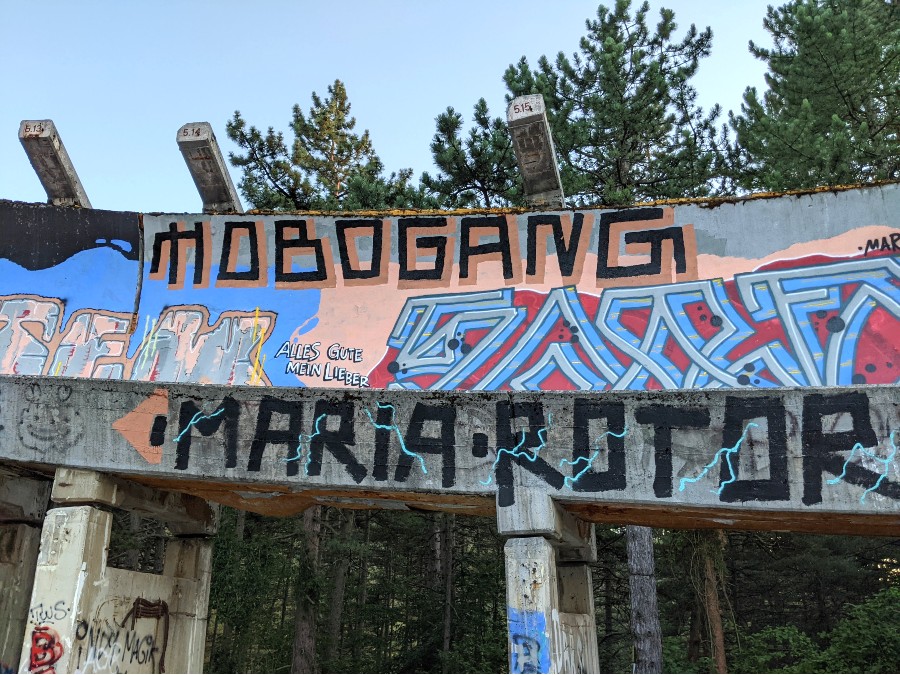
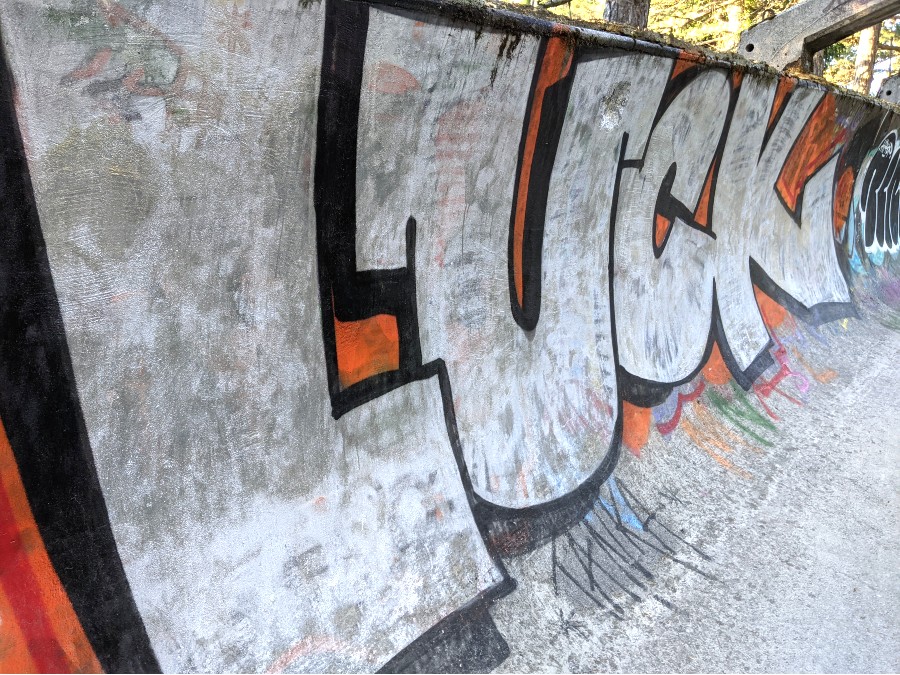
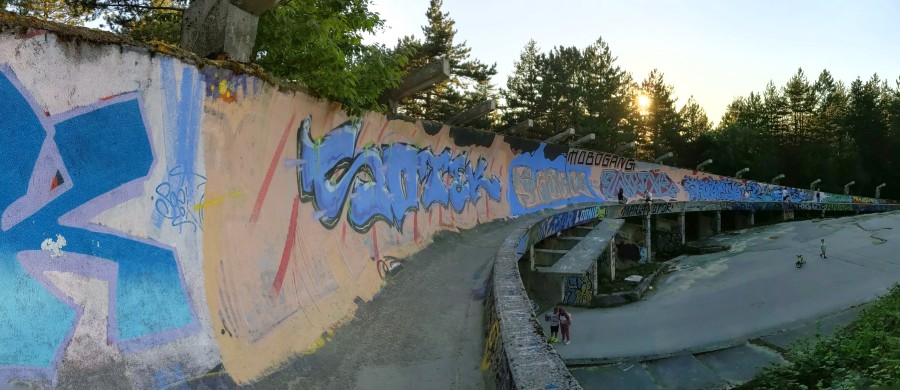
Walking down the entire length of the bobsled runs was fascinating, thinking about how quickly things can drastically change.
I emerged from my concrete history lesson and made my way to a bench overooking the city as the sun set, gorgeously backlighting the cable cars as the city began to glow far beneath me.
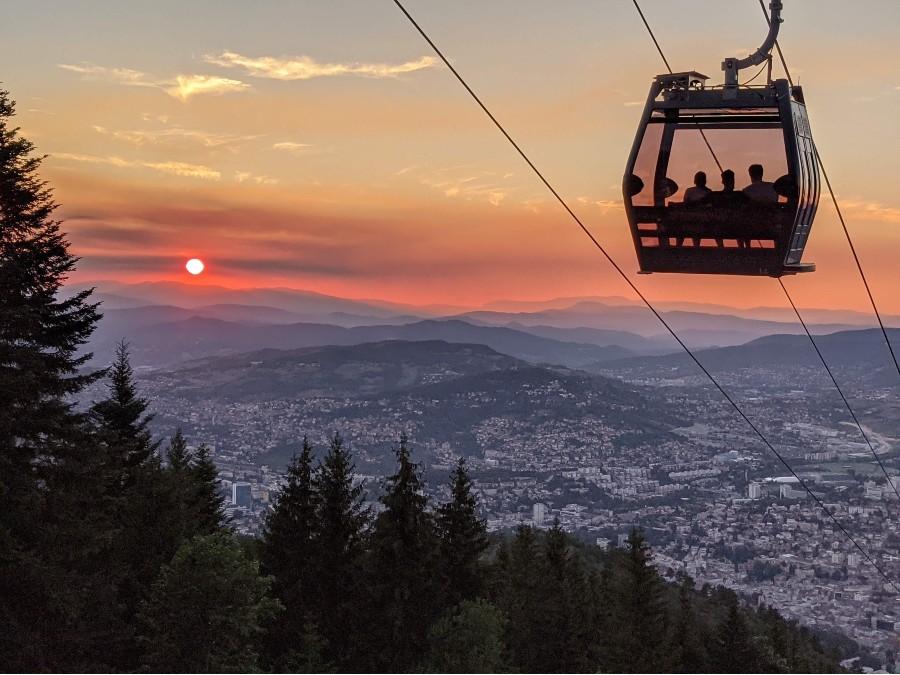
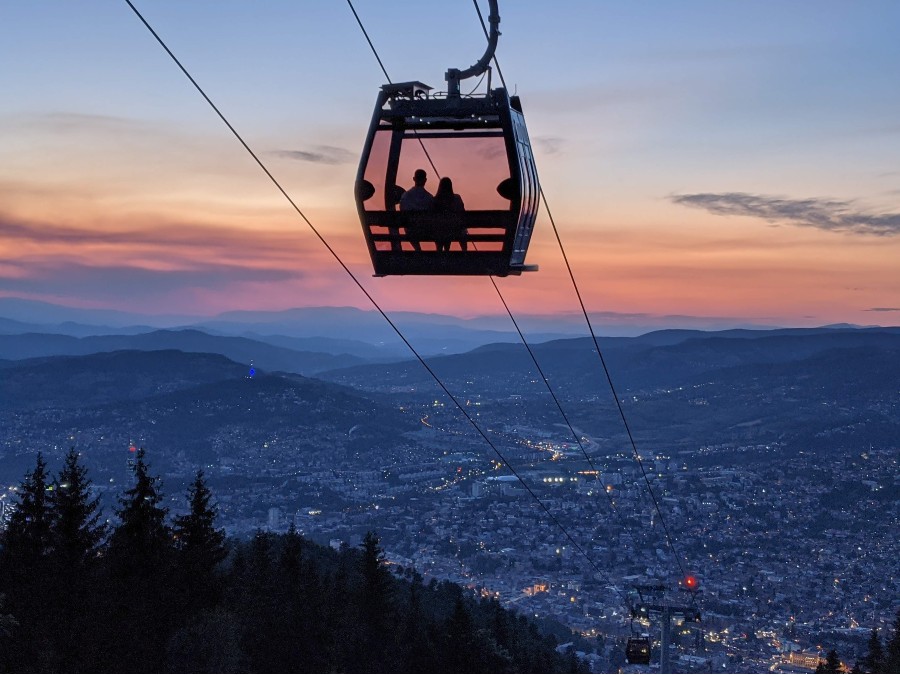
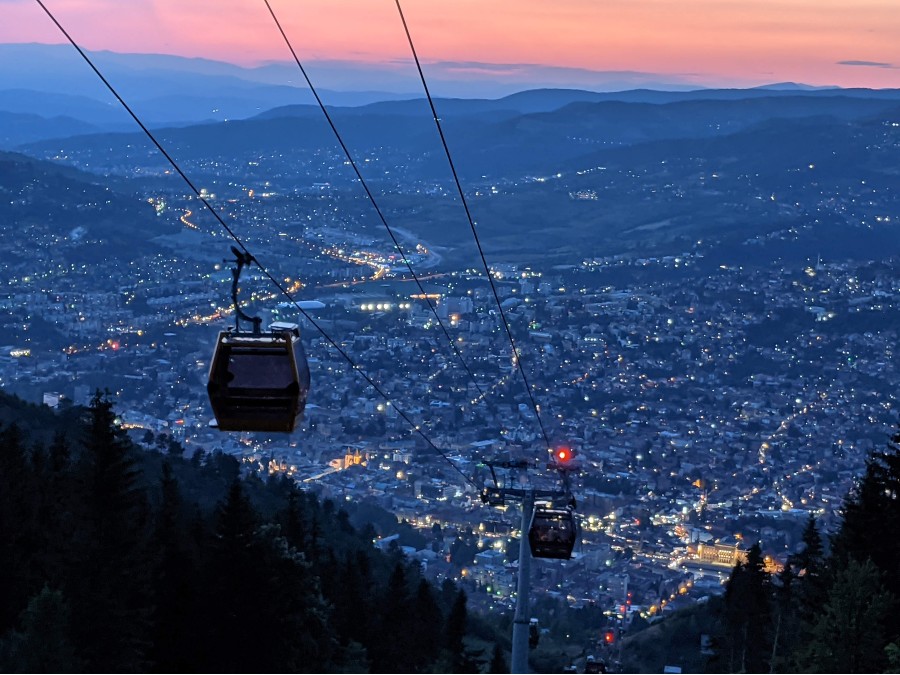
But don’t take all of this to mean that memories of war are all that Sarajevo has to offer.
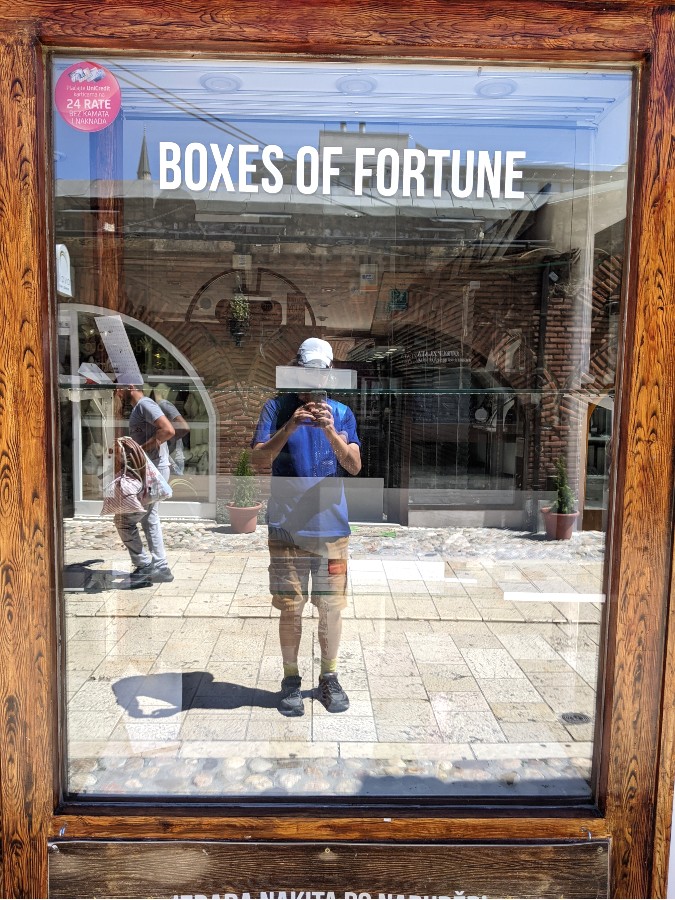
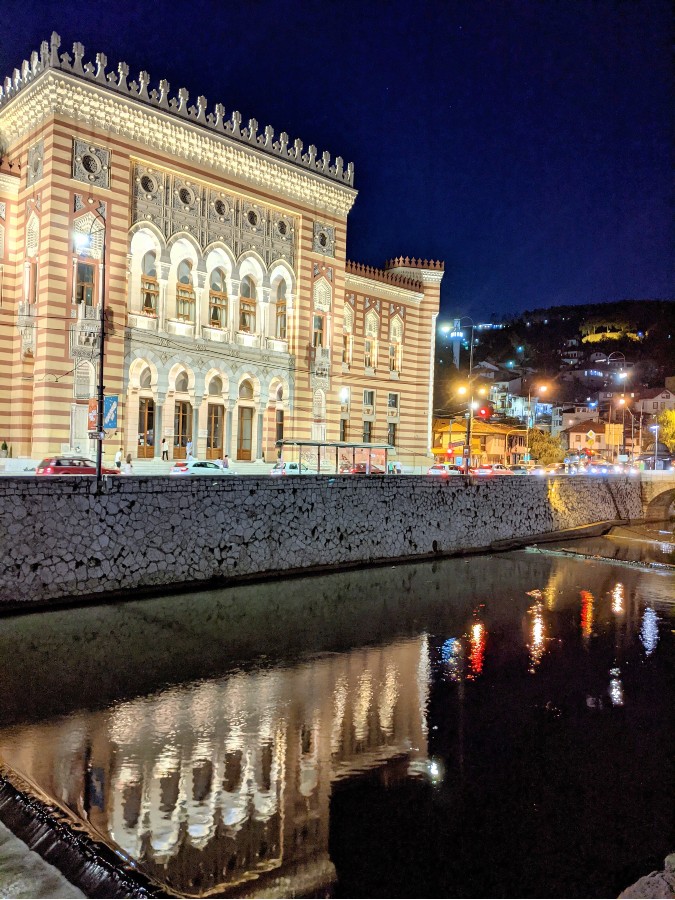
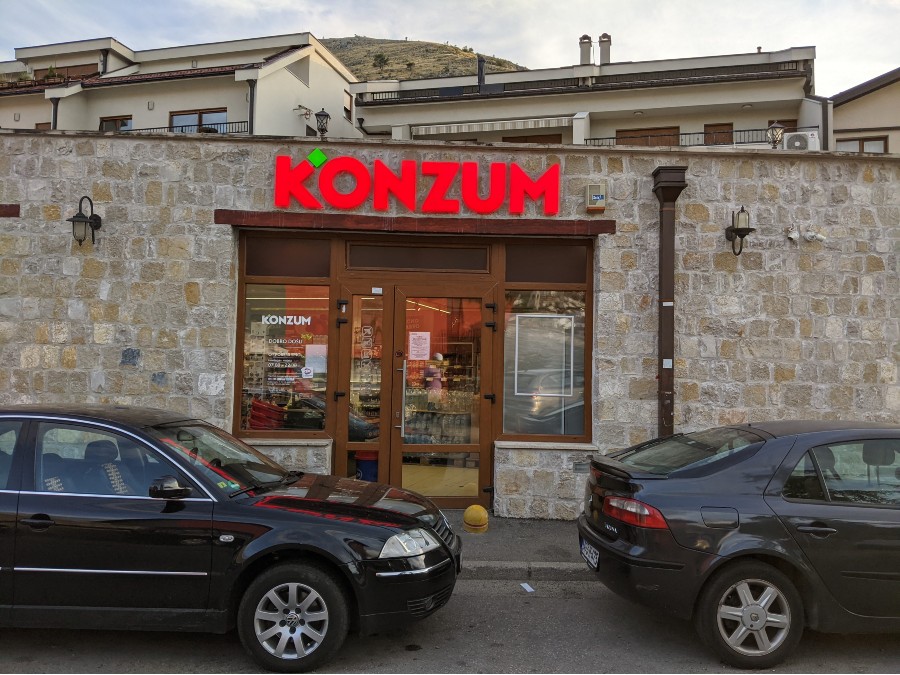
They also have this goddamned weird thing:
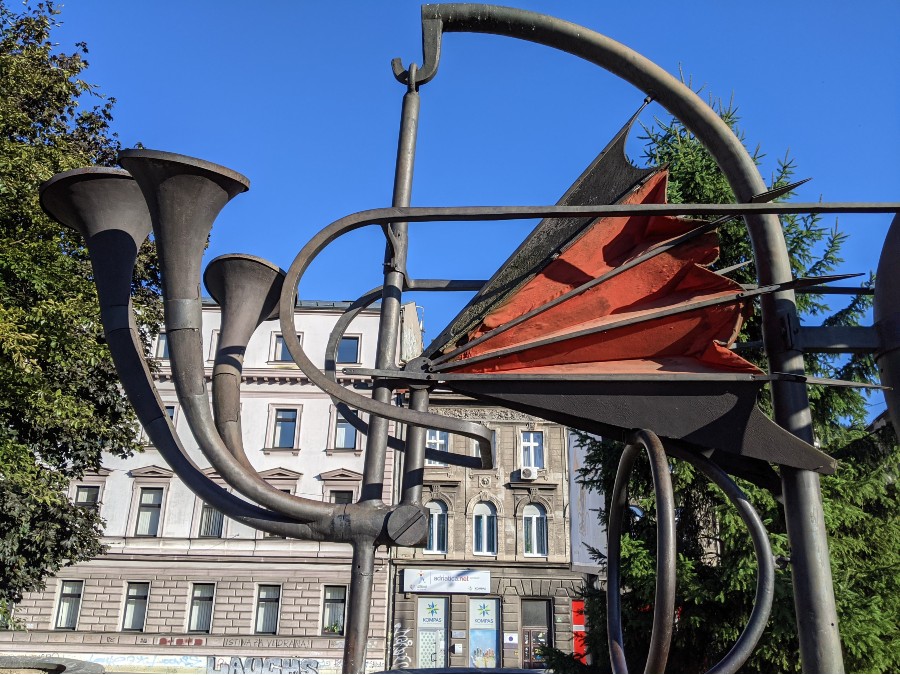
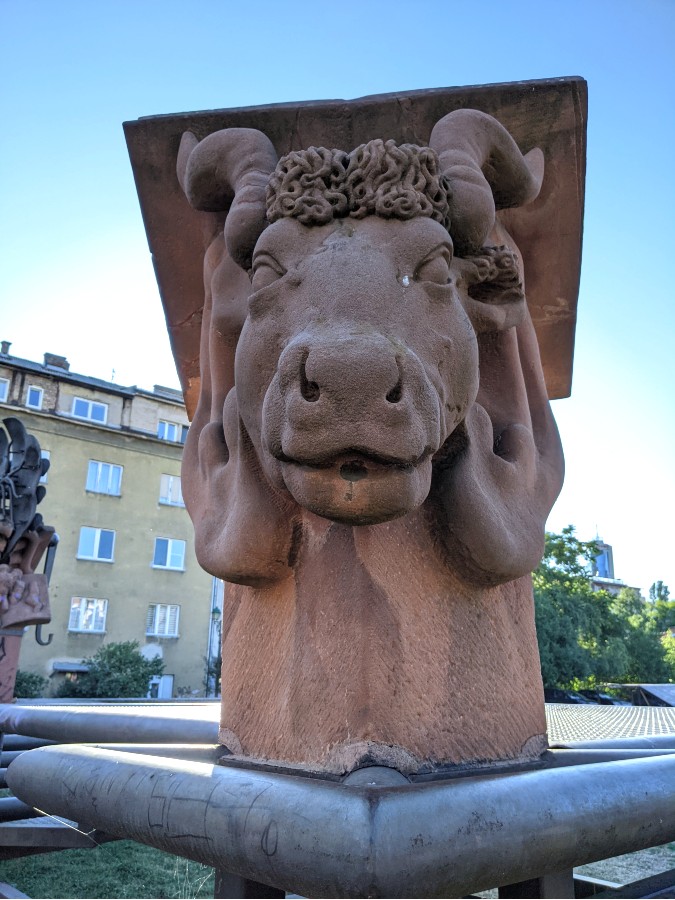
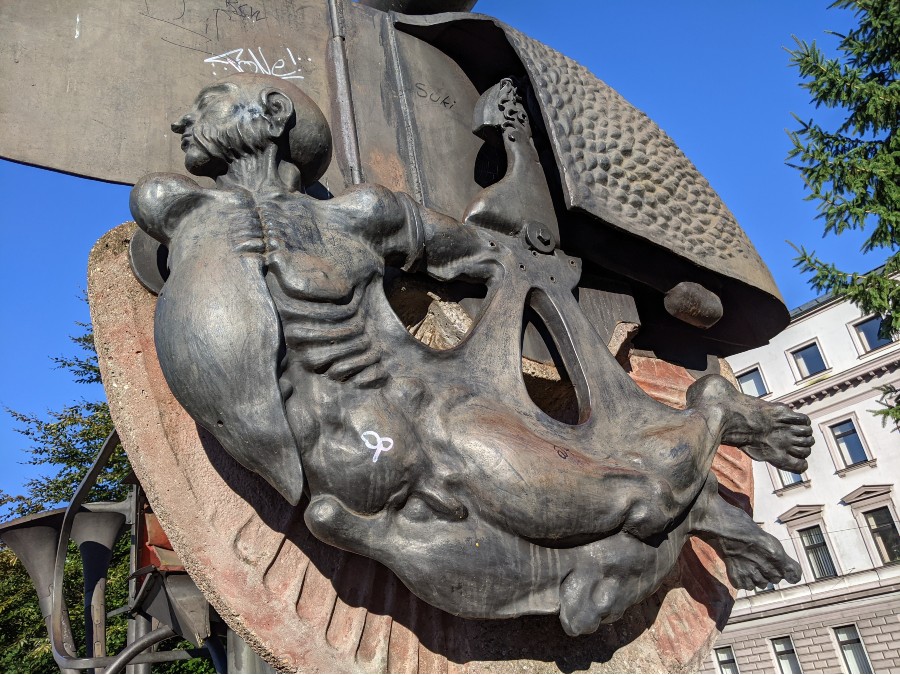
A park in the city hosts this large and elaborate noise-making sculpture, or rather I took everyone’s word for it that the sculpture made a bunch of probably-hilarious noises, all of the moving parts were covered in padlocks when I was there, likely to protect the sanity of the locals, and the whole big mess sat sadly silent.
I had crossed over into Bosnia and Herzegovina by land from Croatia, which somehow involved four different passport and covid vaccination checks. This had something to do with the fact that Croatia is awkwardly cut in two by a little strip of Bosnia and Herzegovina that gives that country a tiny bit of all-important access to the sea.
The southern section of the country is the Herzegovina in Bosnia & Herzegovina, and Herzegovina means the Duke of Wine. It’s best not to worry too much about why one country needs both a Bosnia and a Herzegovina, and just understand that B&H is less a country and more of a gigantic mess stuffed into some country-sized pants. The Bosnian Serbs, Bosnain Croats, and Bosniak Muslims (who are sort of the Bosnian Bosnians) that live in these lands cannot agree on a single thing, to the degree that after B&H declared independence from Yugoslavia, eventually someone from the EU had to design their flag for them, because nobody could agree on what kind of colored rectangle they should use. So they got a blue flag with a yellow triangle on it, because the EU likes those colors and Bosnia is shaped kind of like a triangle.
I was staying in the ancient city of Mostar, where I hired a guide to take me around the region and explain what in the hell was going on in Herzegovina, like why this pretty small town had two bus stations (one for the Muslim part of town, one for the Christian part, because nobody can agree on anything) or why B&H has three presidents (the three main ethnic groups in the country take turns ruling it for about 17 minutes each).
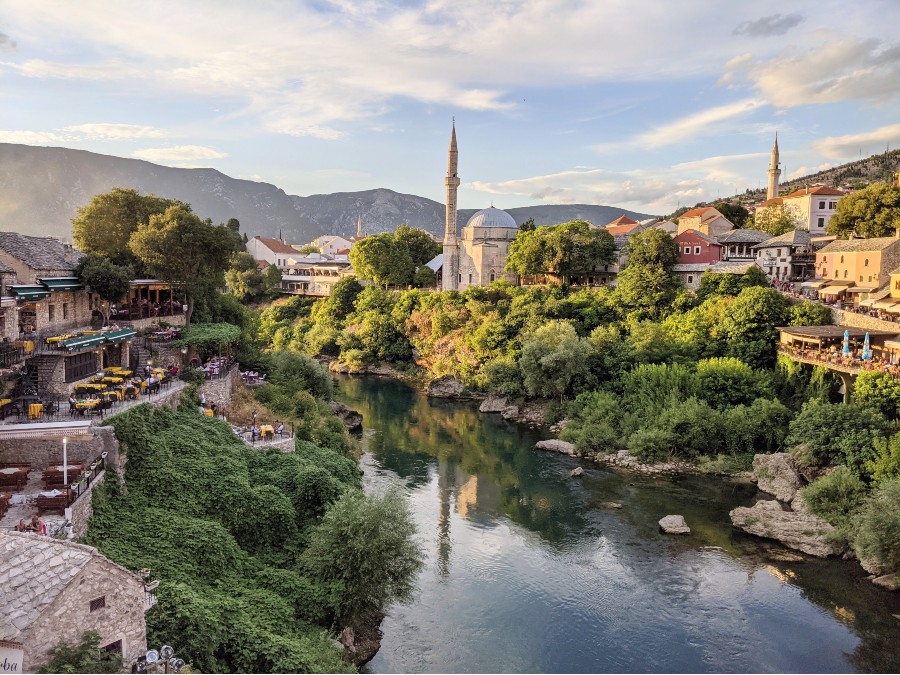
Mostar is most famous for its cool bridge, Stari Most, which was built in such an improbable shape that the architect fled town the day it was finished, in case it fell down.
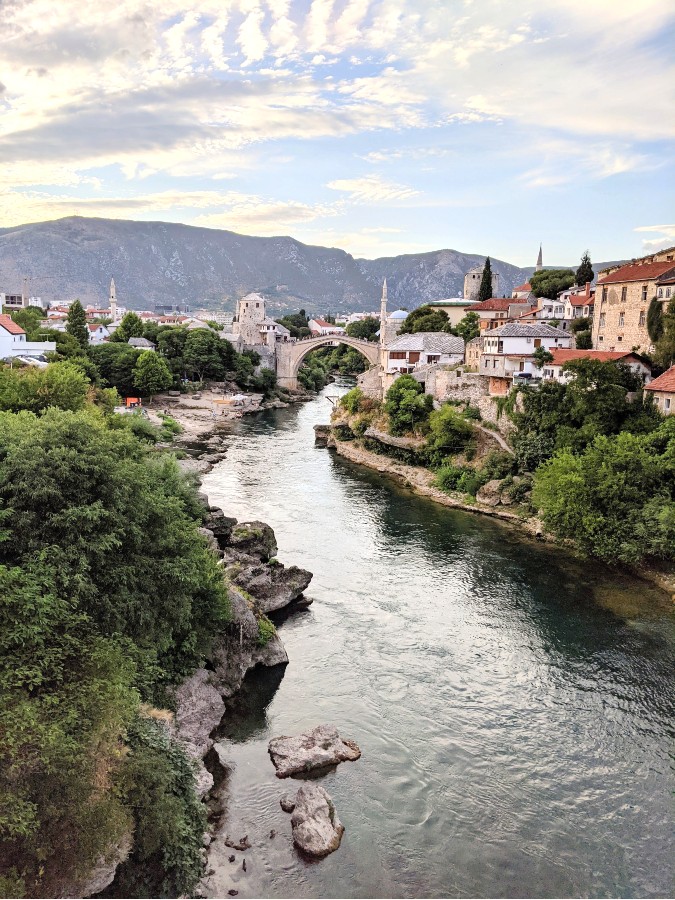
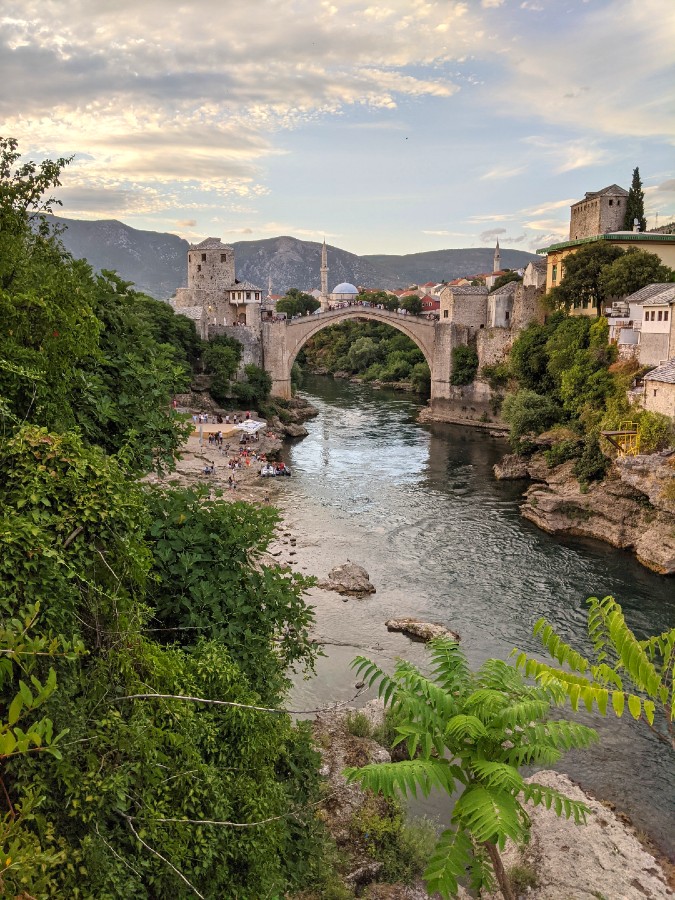
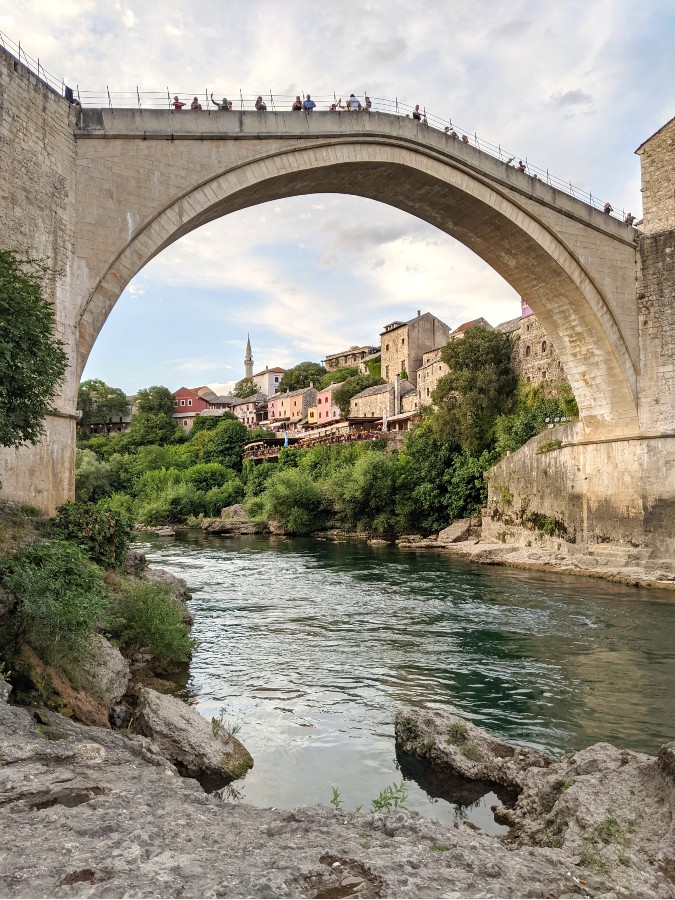
While I was there, local men were diving off the apex of the bridge into the river below, but not before milking the drama for all it was worth for really way too long and collecting tips in their hats from the assembled crowd.
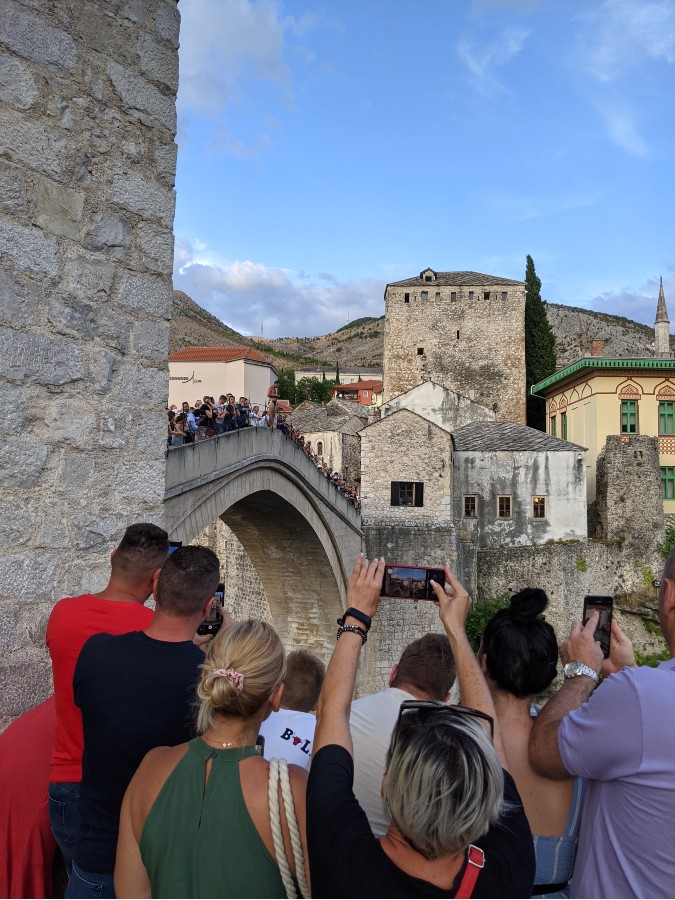
My guide took me and three French girls out across the countryside to visit the Kravica Waterfalls, where every out of shape Bosnian dude and his hot girlfriend were frollicing in the water.
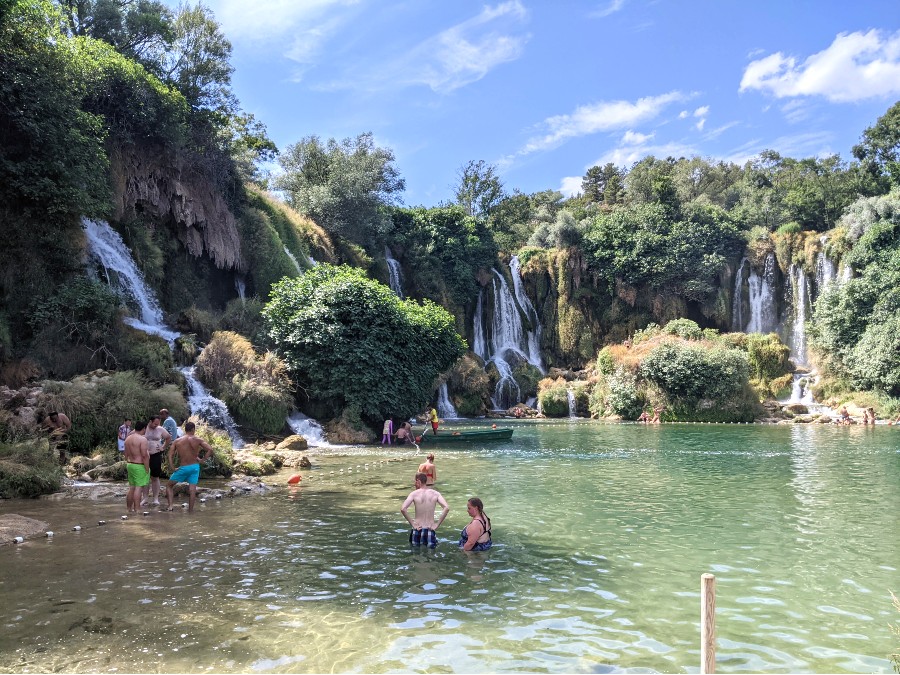
We carried on to the old village of Počitelj, where I hiked up to the fortress walls for the lovely view.
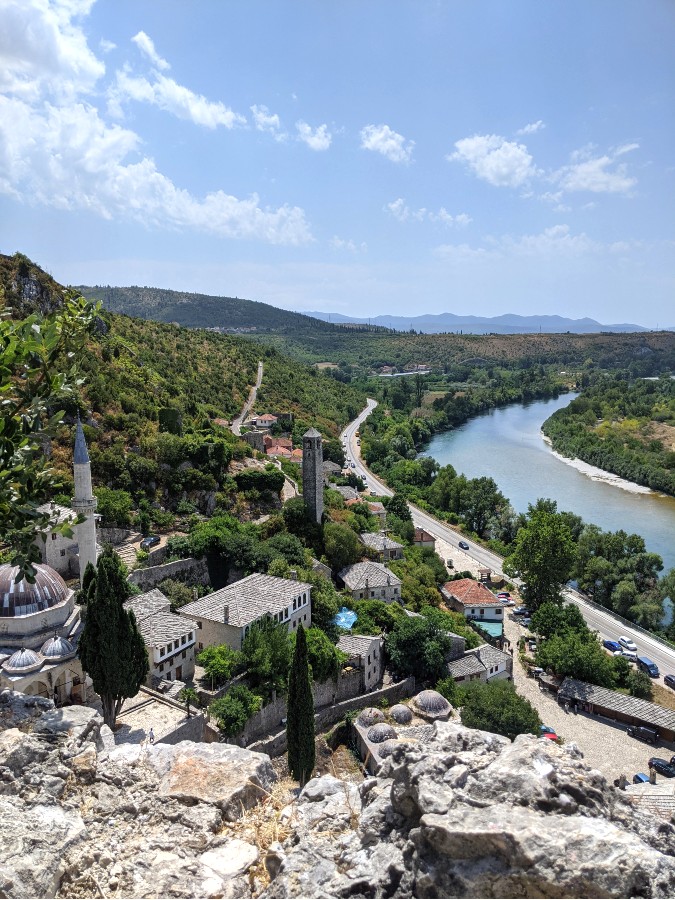
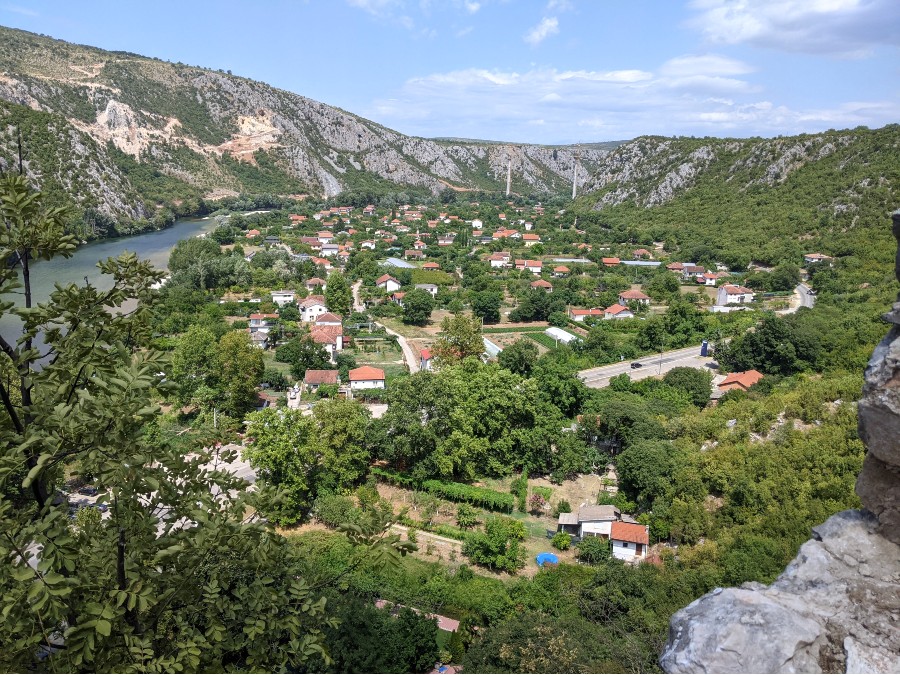
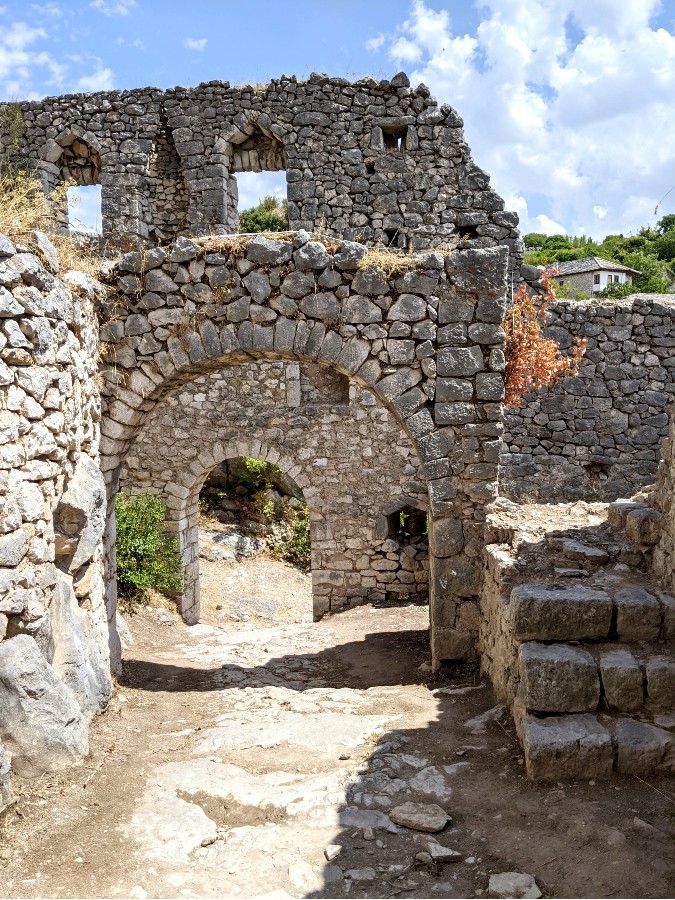
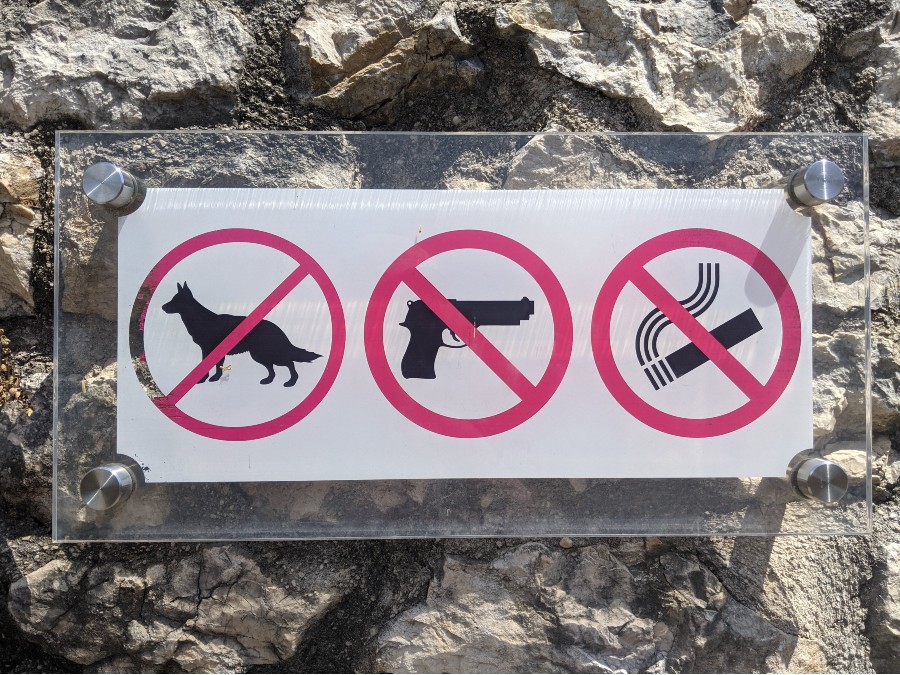
We stopped for a bit at a swampy area where to rivers sort of stumbled into each other:
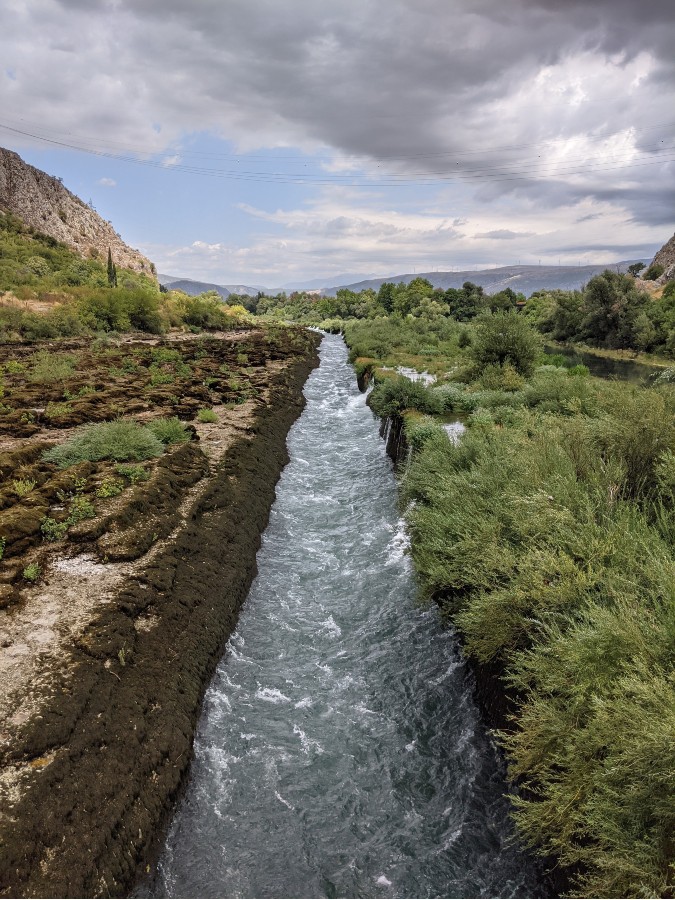
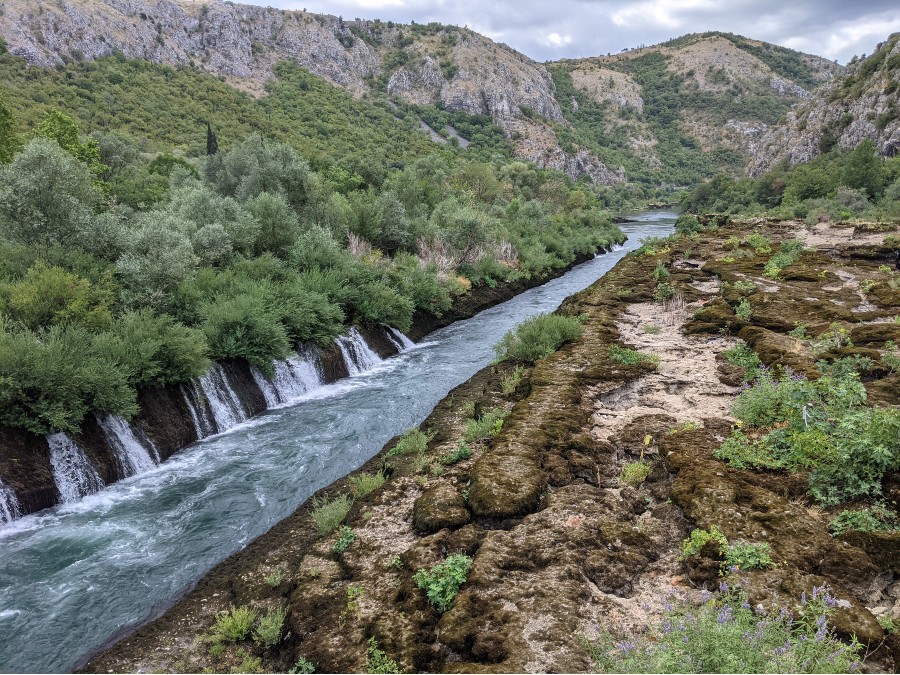
But the highlight of the region was definitely the Blagaj Sufi Monastery, where the girls took a boat into a nearby cave while I explored the interior of the monastery.
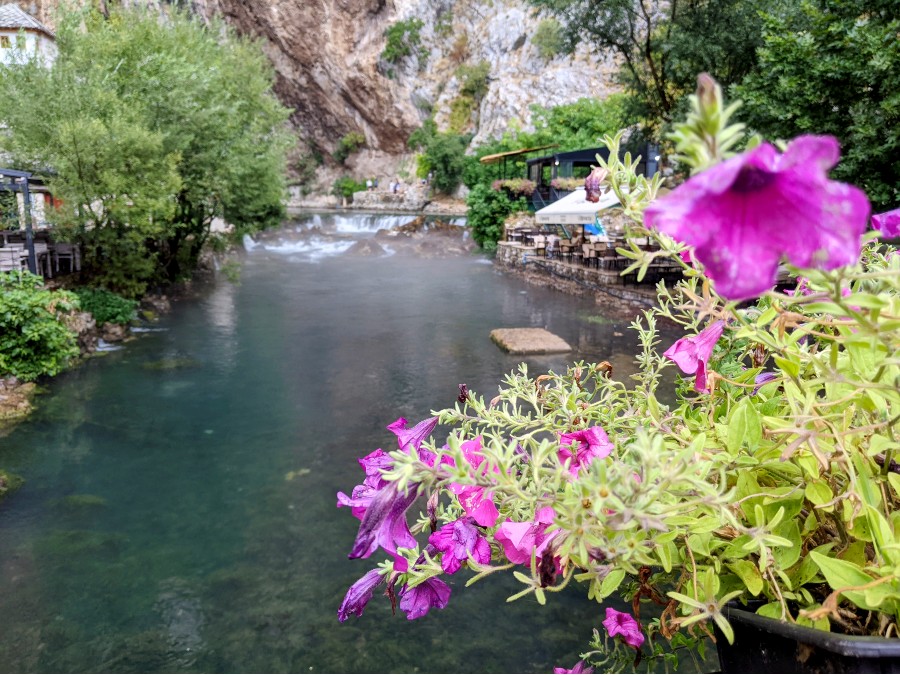
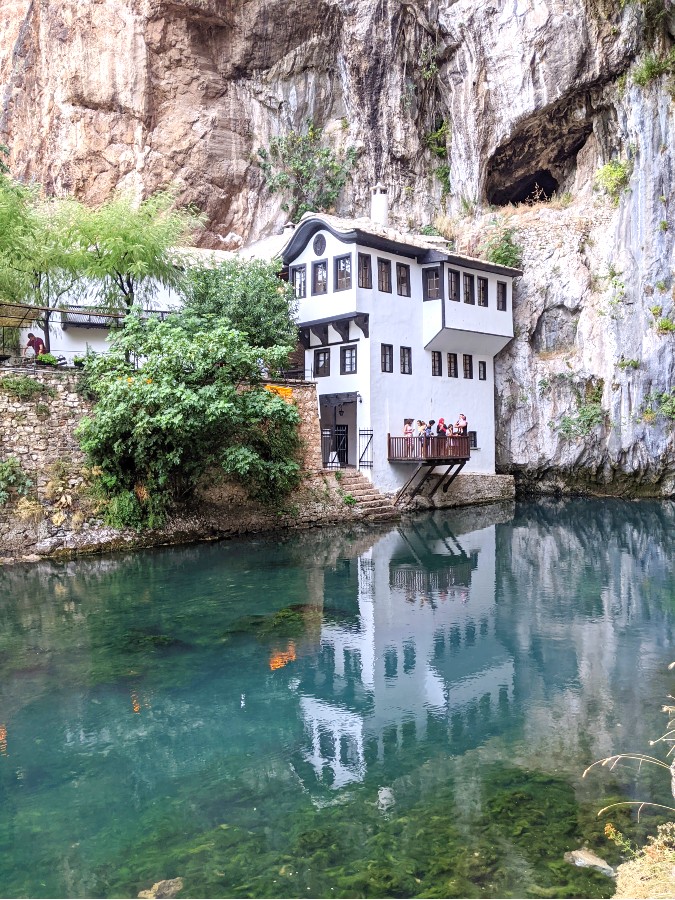
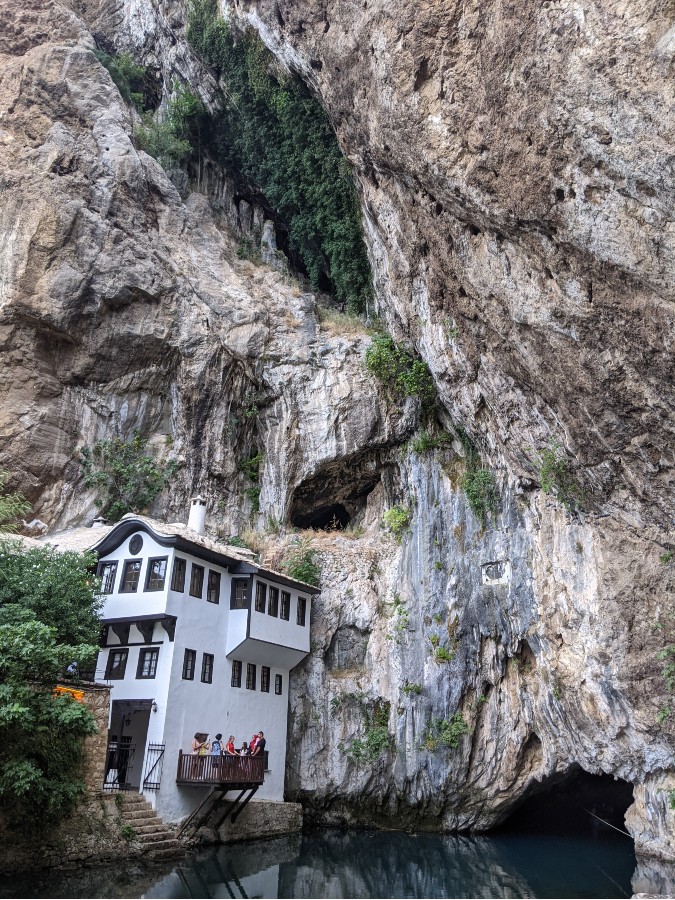
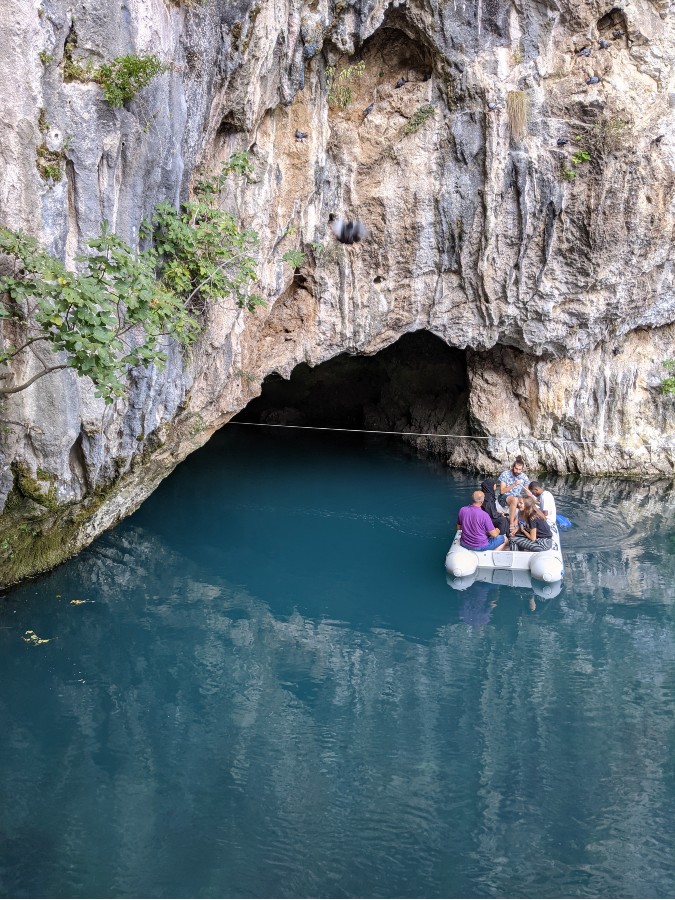
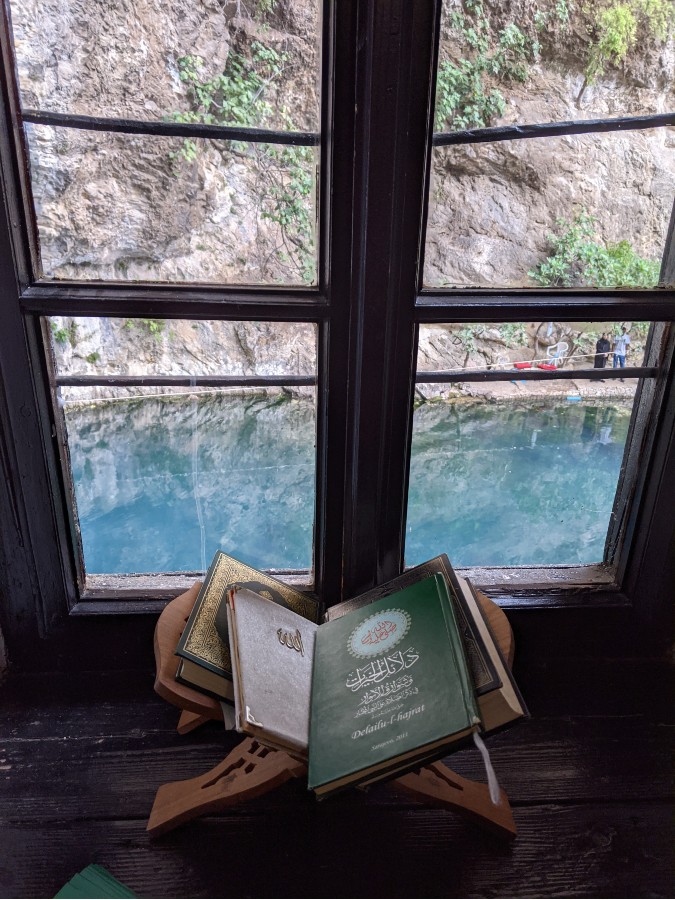
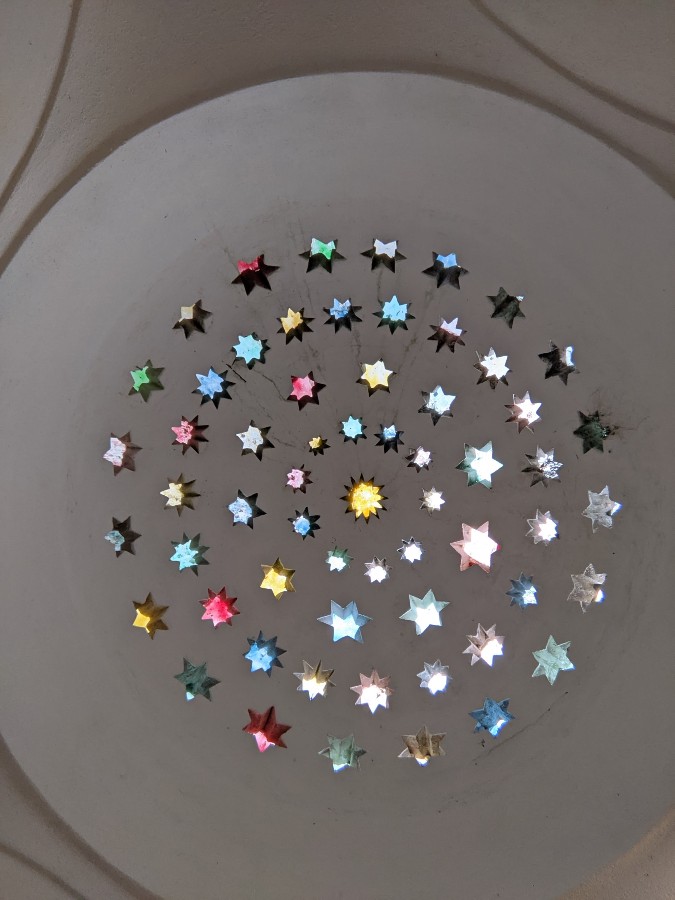
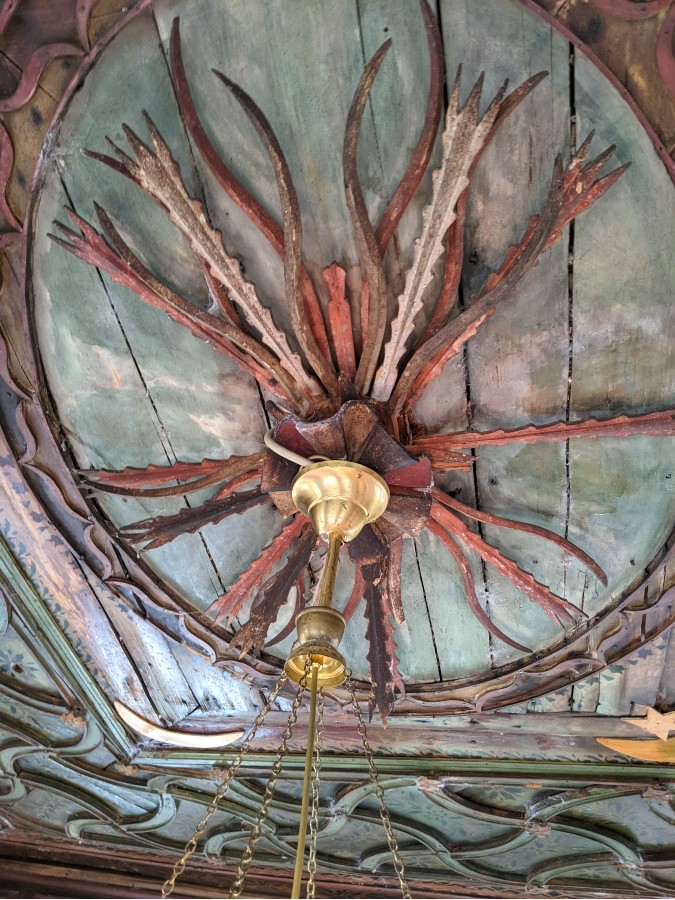
The important thing to remember about the Sufi temple is that getting down is strickly forbidden. No fun, these Bosnians.
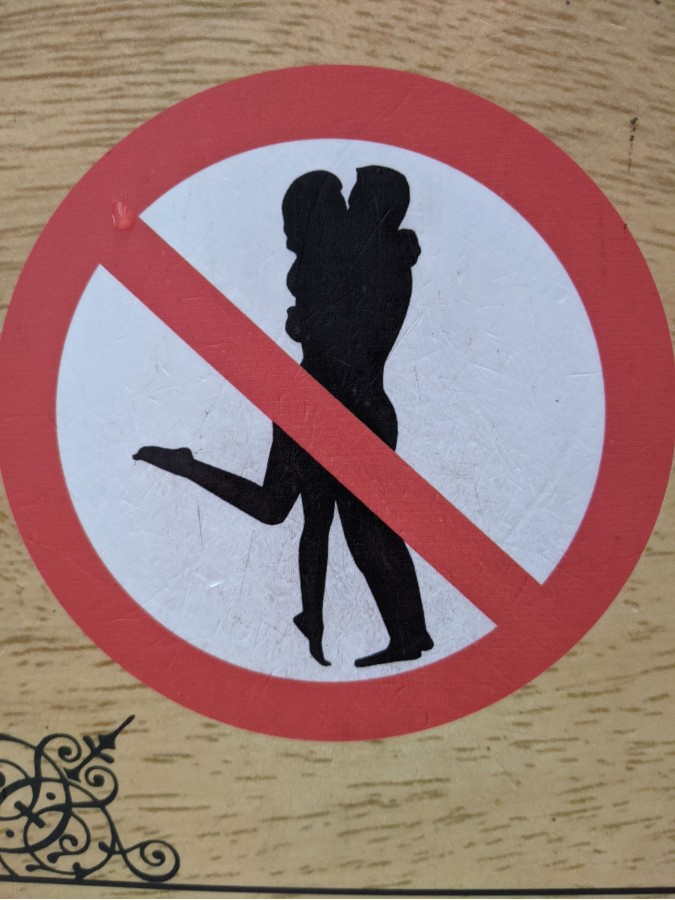
The best part of the day for me though was talking to our guide. He had been a small boy in Mostar during the siege of the city, and he told me stories of running from one pile of rubble to another, dodging the sniper fire just to get food and water, and how the locals hung tires from their famous bridge in a depserate hope that any falling bombs might bounce off of them rather than destroying the ancient bridge.
Talking to him made the entire experience real and personal to me in a way I deeply appreciated, adding to the sensation that these events and this history were in my heart now, not just something abstract in a book or a fleeting image on the news. This is the best kind of education that travel can provide. After the French girls retired to their hotel to barf their everloving brains out, he took me up into the mountains to a point overlooking the entire city of Mostar, and told me blow by blow the story of the Yugoslav wars and everything his amazing people had been through.
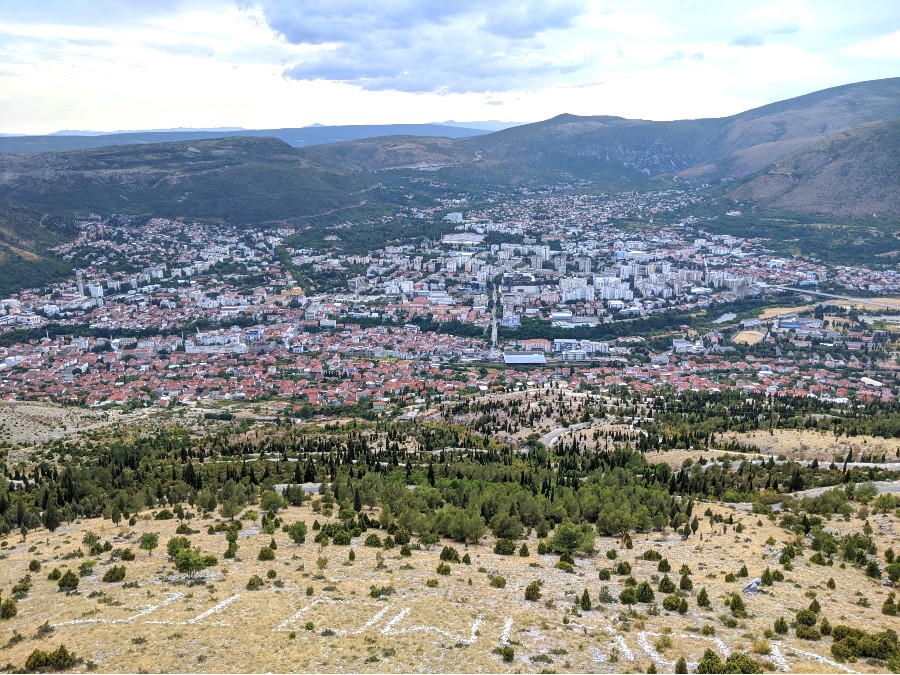
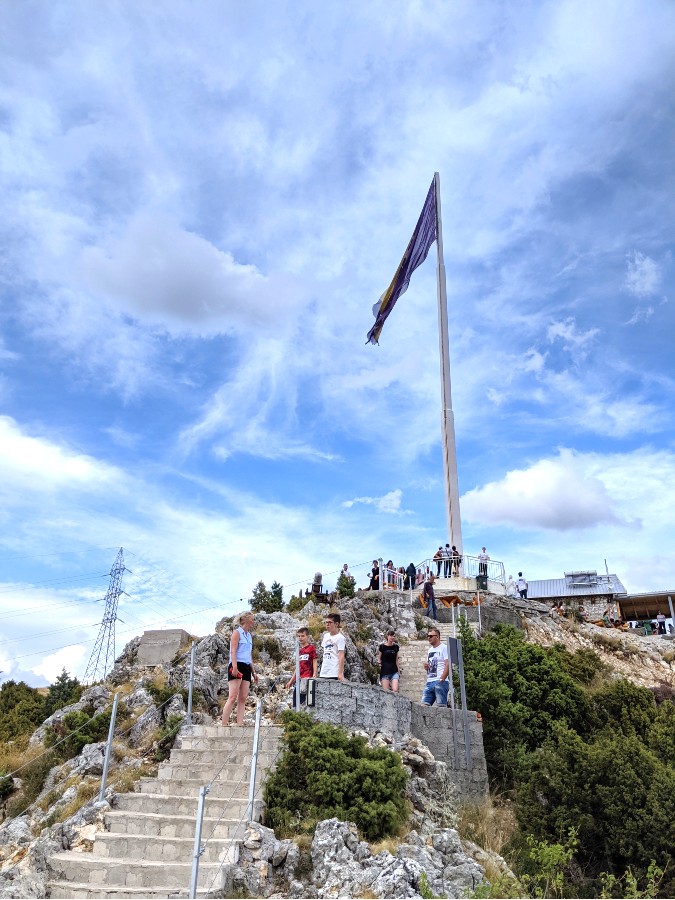
In 1981, six teenagers in the village of Medjugorje in Herzegovina were either out looking for lost sheep or a place to smoke their Virginia Slims without being hassled by the man when they saw a glowing silhouette on top of a nearby hill. Climbing the hill to investigate, they were confronted by an apparition of the Virgin Mary, who told them ten secrets to share with humanity, like the best things to order off-menu at In ‘N Out and how to get blood out of cashmere. Mary continued to appear to the various teens regularly for a few years in the early 80s, and then sporadically for many years after. Over this time, Mejugorje became a major Catholic pilgrimage site, drawing hundreds of thousands of visitors every year.
Considering the pretty mind-blowing experience I’d had at Fatima in Portugal last summer, I wanted to check out a competing MaryMania location. It wasn’t part of the day tour I was on, but it was nearby and I convinced our guide and the three food-poisoned French girls I was touring with to stop in Fatima for a few minutes on our way back to Mostar. While they waited and I’m sure filled the car with unthinkable farts, I ran around and tried to tune into what was going on in Miracleville.
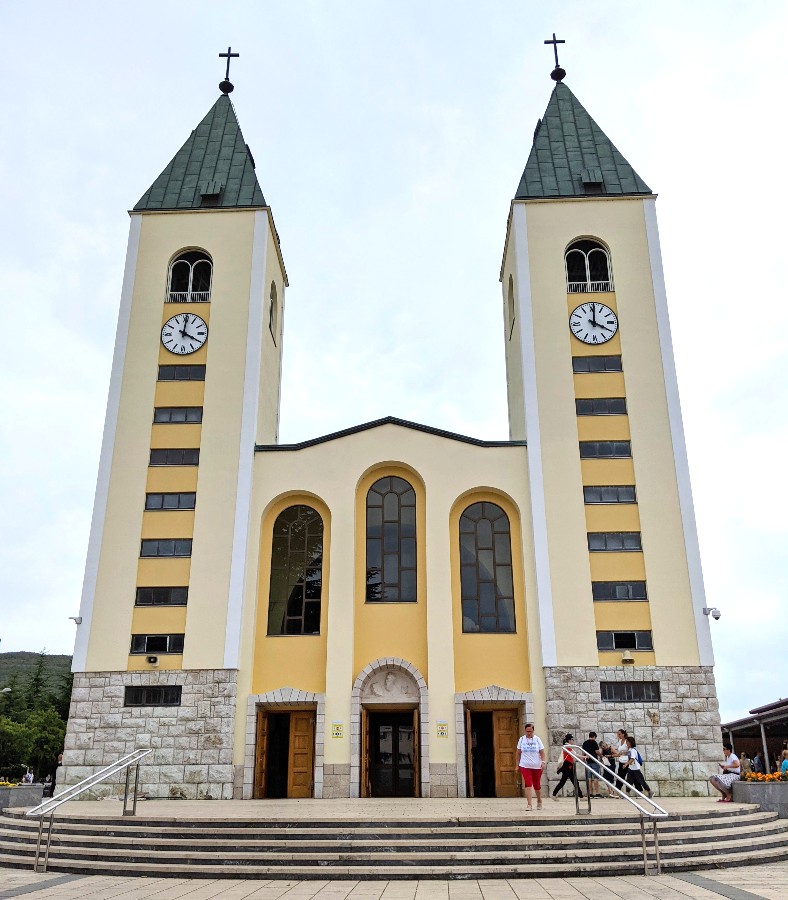
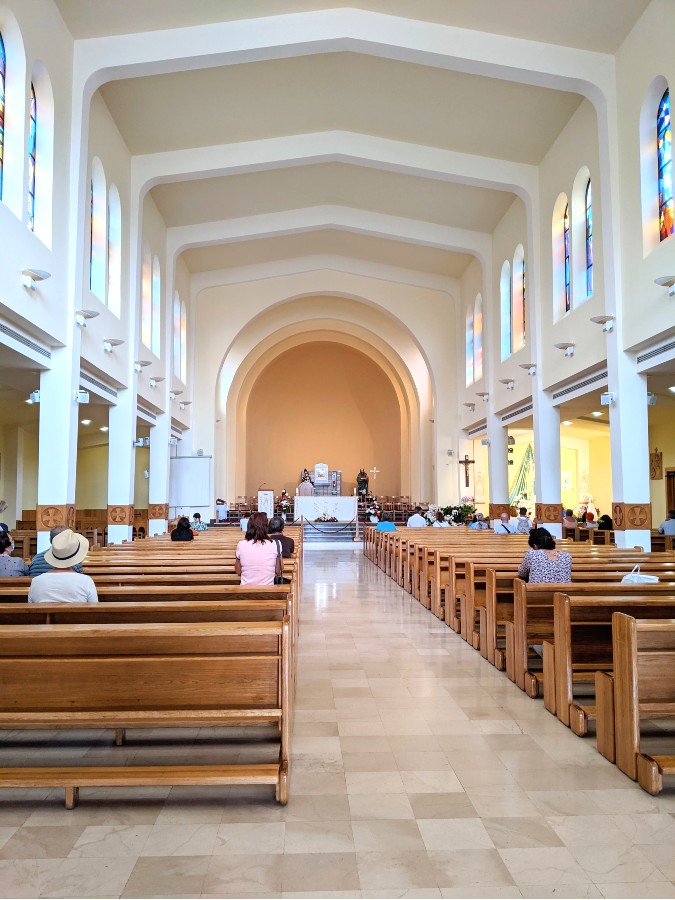
The lines of pilgrims waiting to have confession stretched across the plaza outside the church.
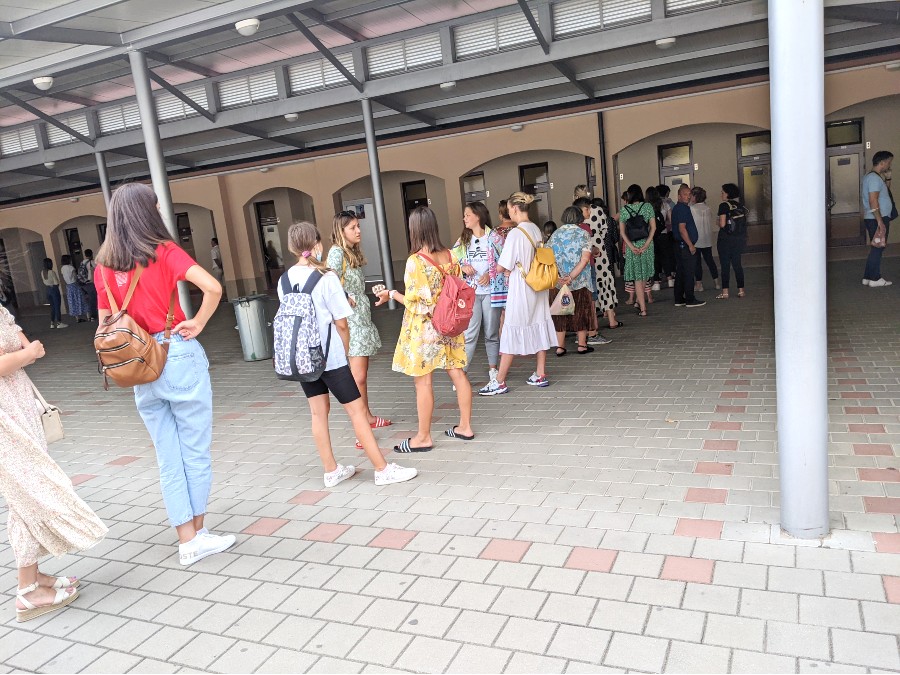
The energy inside the church and all around the site was very intensely uplifting. It reminded me of when I return to my apartment after months away traveling, when the space has sat empty and all of my crystals and orgonite have been doing their thing in peace the whole time, filling the space with high-vibration energies that accumulate and accumulate. Walking back into my home for the first time after being out in the low vibrations of the world and a hundred crazy places is overwhelming, the upliftment so strong it’s hard for me to stay conscious, I feel like I’m going to physically pass out and my consciousness is going to go up into some higher state outside of my body. The church in Medjugorje felt the same, whatever was going on with the Mary visitations or the millions of pilgrims bringing their highest aspirations to this space, the energy here was very impressive.
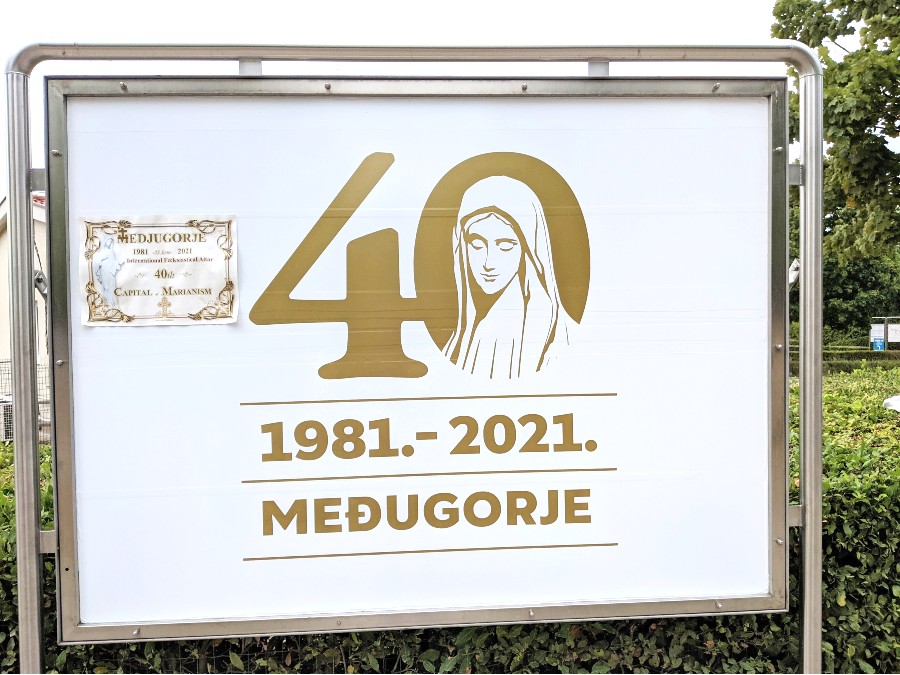
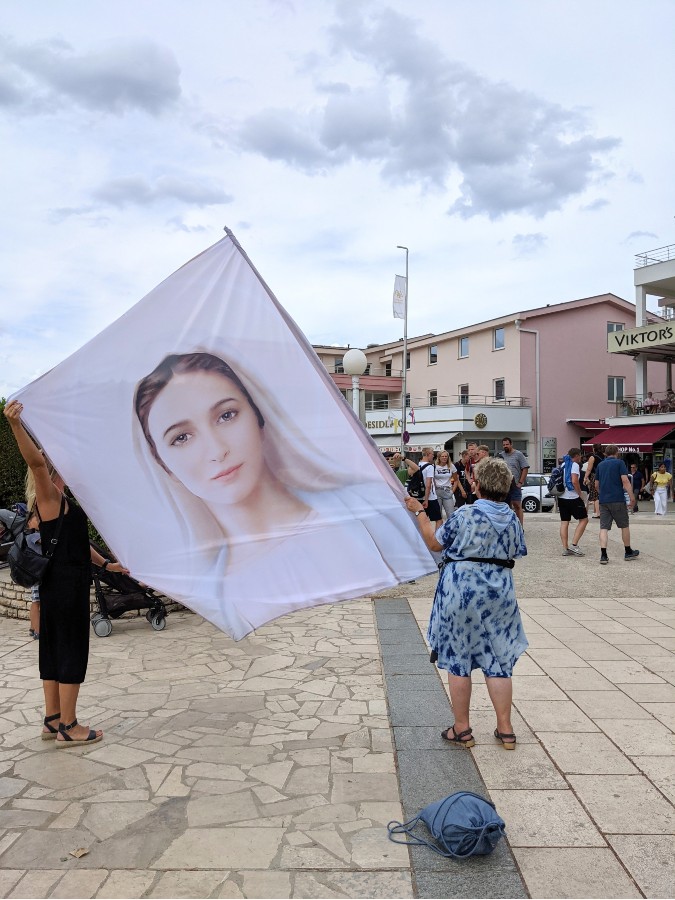

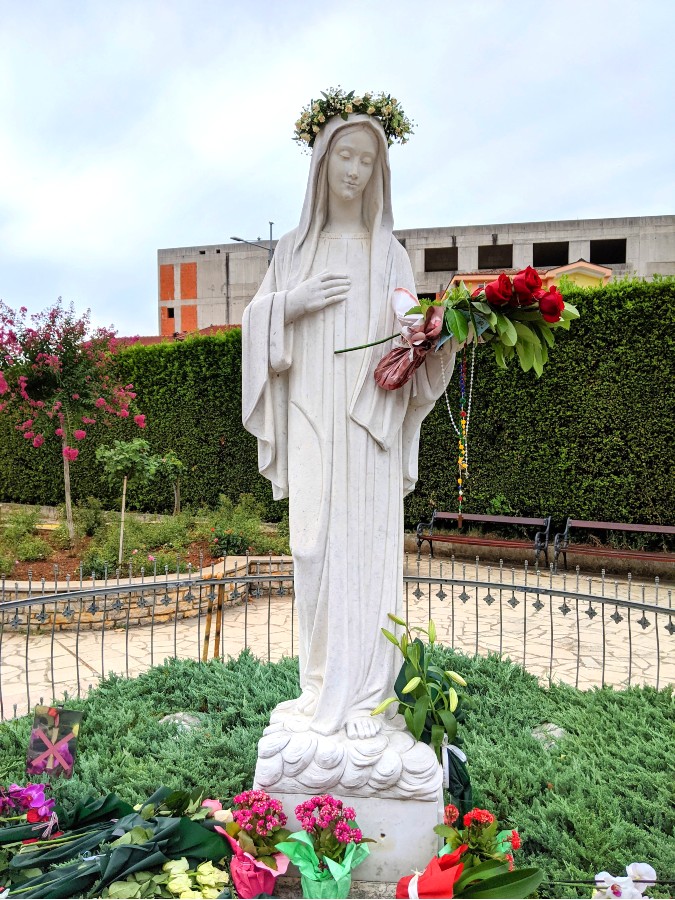
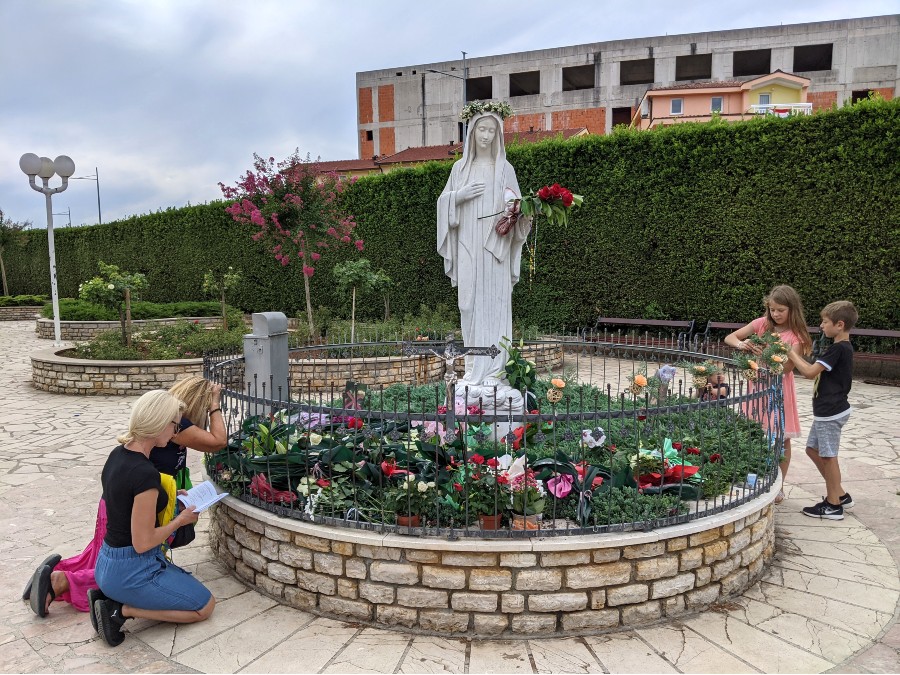
Outside the church complex there was an orgy of Mary crap, for the people who can’t feel energies but really feel chintzy souvenirs. Something for everybody.
In the middle of absolute nowhere in Bosnia there is a town called Zavidovici that has massive stone balls. Some take these to be evidence of an ancient and forgotten culture that made giant stone balls for some possibly spiritual purpose. Others take them to be an improbable-looking natural occurrence, where the Earth just feels like making big, perfectly round rock balls sometimes. Don’t judge the Earth, you’d get bored sometimes too if you were billions of years old.
One of the first obstacles in getting to Zavidovici to check this shit out for yourself is figuring out how to say the name of the town so you can ask the bus station ticket guy for a ticket that will get you there. The very kind woman who was running the little hotel where I was staying near the pyramids gave me a ride to the bus station, and in her very limited English asked me where I was going.
“Za-vee-do-vee-chee?” I replied.
She looked at me like I had just said I was going to Itty Bitty Kitty City.
I began to mime giant stone balls, which is not something you pantomime every single day.
“Ohhh,” she responded. “Za-vee-doch.”
Wait, so you skip the second V and then… whatever Bosnia.
I was clearly unable to understand even basic things like “ovici” being pronounced “och” so she accompanied me into the bus station and told the ticket guy where I was going. Thanks, nice Bosnian hotel lady who had clearly never had a weird illiterate vegan guest before.
The bus took me out across Bosnia to Zavidovici, which is not a place anyone ever goes to for any reason. From the bus station it was a hot walk carrying all of my stuff for about an hour until I saw the hand-drawn signs along the side of the road that said “GIANT STONE BALLS” thisa way, and eventually after a trek through the woods I was there. It had clearly been some kind of minor tourist attraction at some point, as there was a bar and a little restaurant and whatnot, but I was greeted only by stray dogs. Maybe it was a covid thing. It felt like the owners were going to return any moment and angrily find me ogling their stone balls, but no one ever came. And I eventually was able to work it out with the stray dogs that we’d both leave each other alone, so I could enjoy the balls and they could enjoy sleeping and waiting for the pandemic to be over.
The biggest of the stone balls was indeed impressively huge.
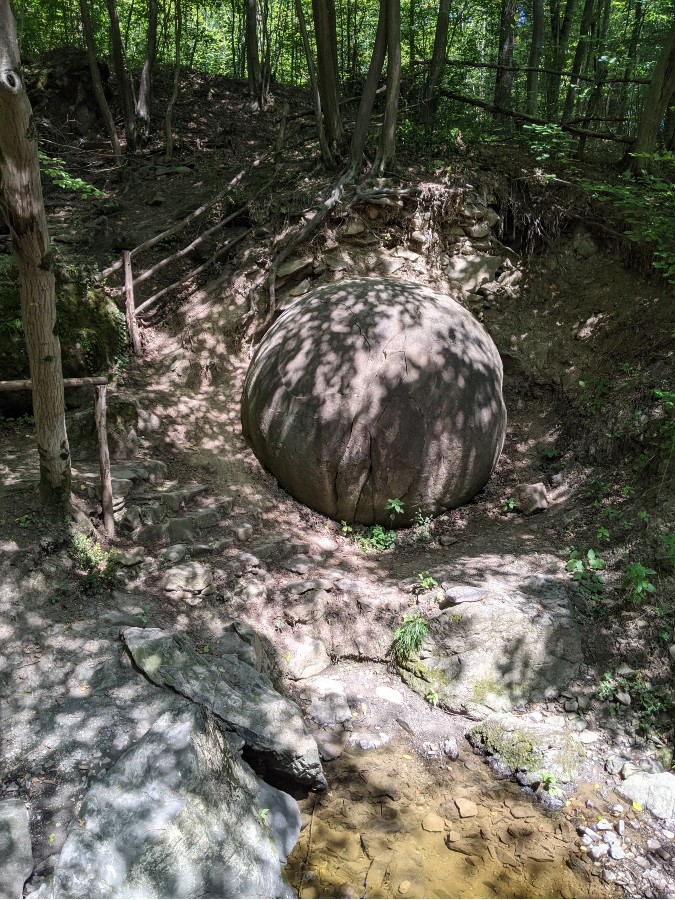
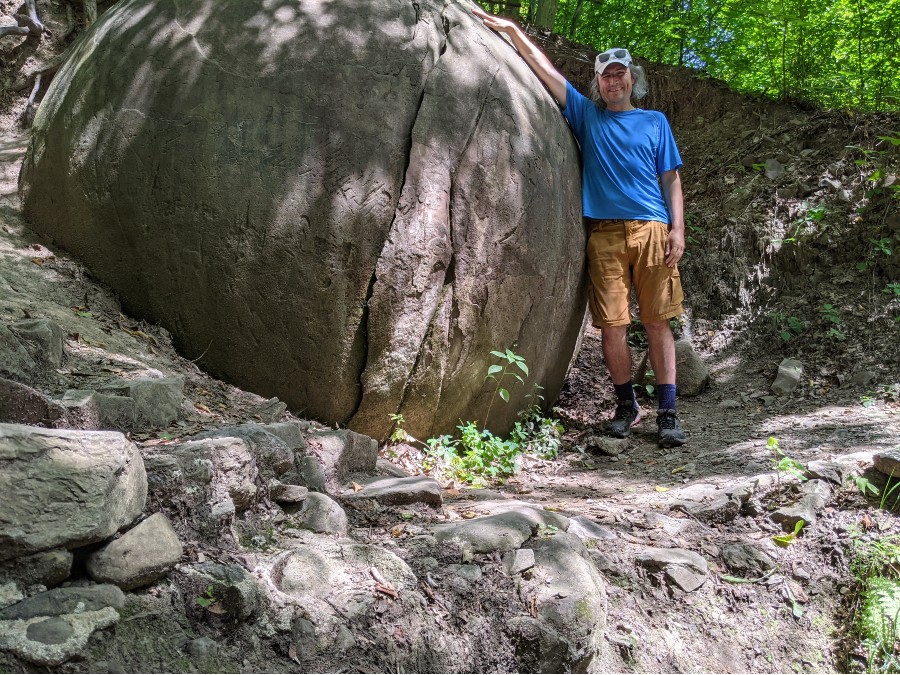
I tried to peek underneath it for any signs of Indiana Jones but I saw none.
Since nobody was looking I was able to scramble up on top and meditate on the giant ball for about a half an hour.
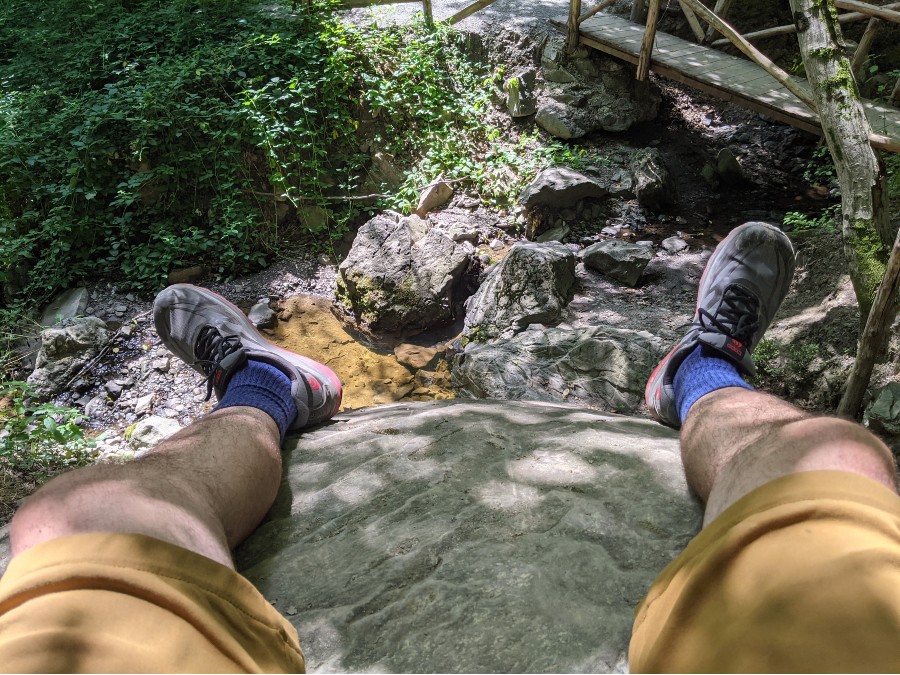
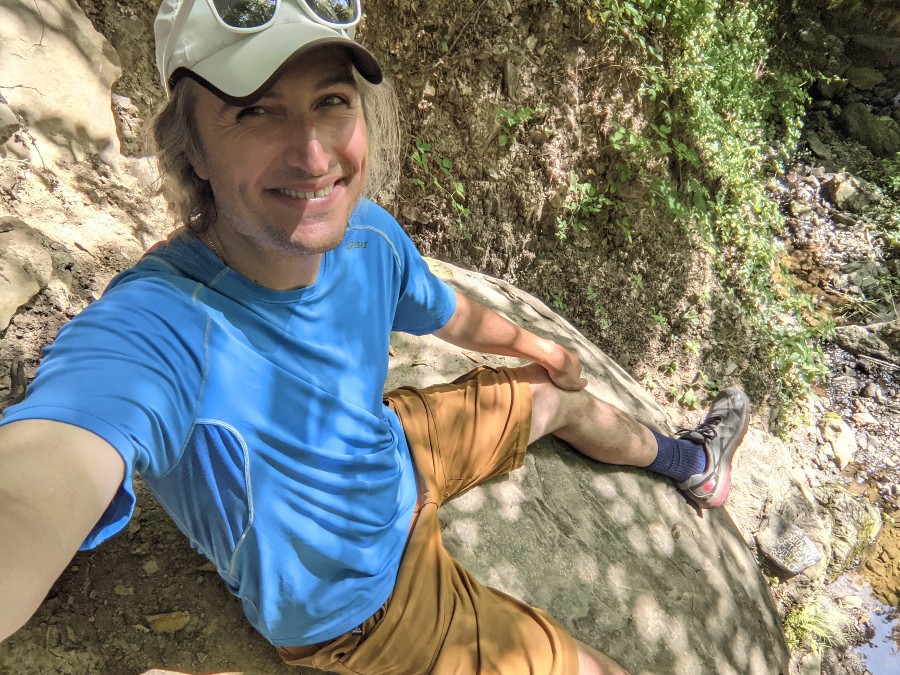
The environment was lovely, with a little stream trickling past the front of the mondo stone ball and nature quietly happening all around me. I couldn’t feel any special energy from the ball itself, which led me to believe they probably are naturally occurring, certain elements that just happen to fuse together in a spherical shape at the right temperatures or whatever the hell happens down underground when nobody’s looking.
There was a park on the opposite side of town that had even more smaller balls, but it was a solid two-hour hike in the heat carrying my bag to get there and I felt like I’d already got what I came for, so I took the next bus to a slightly bigger town, where the international bus would leave me for dead on a platform in the middle of nowhere until, suddenly, improbably and several hours late, it appeared like an apparition out of the night and whisked me away to the magical land of Slovenia.